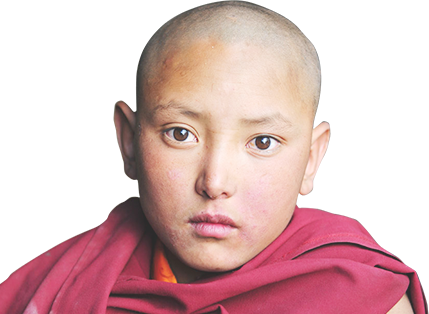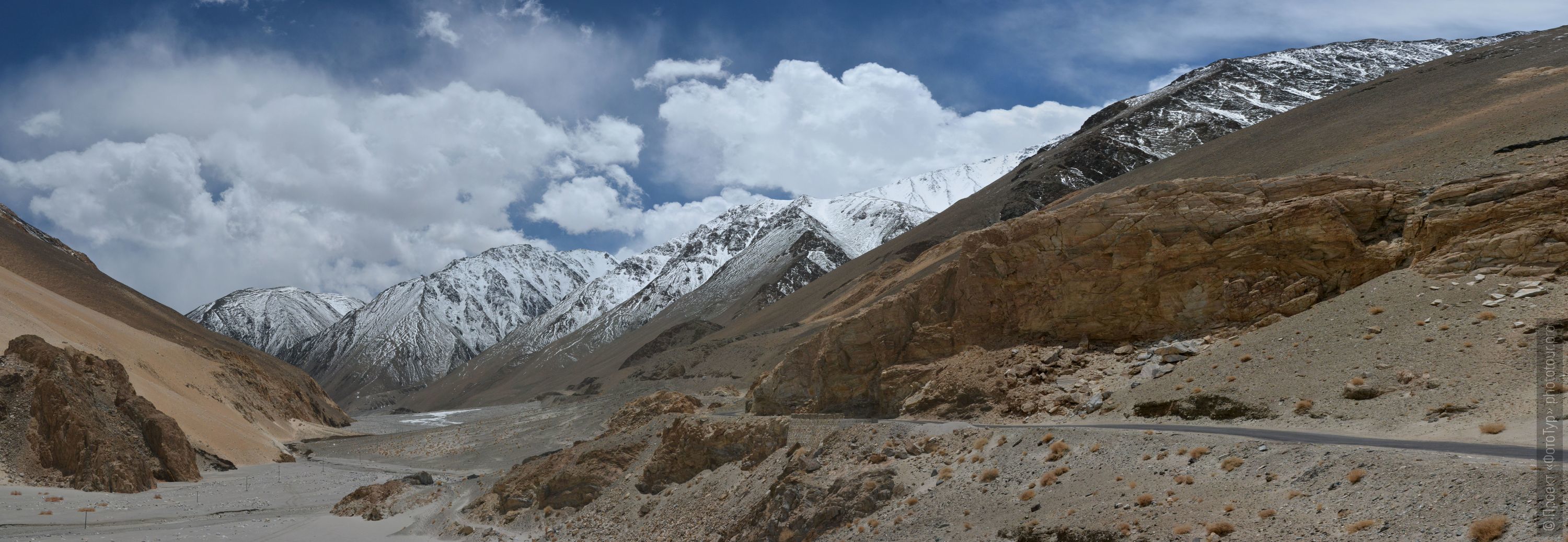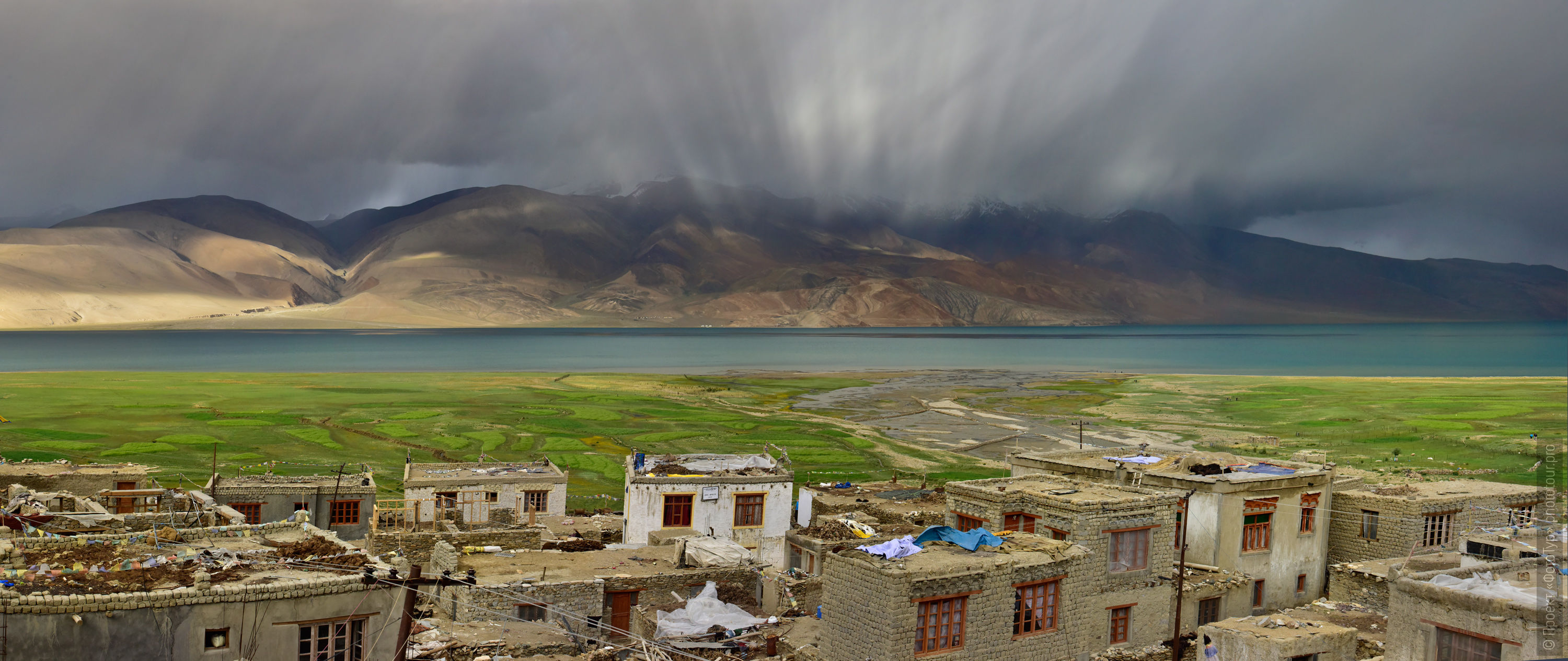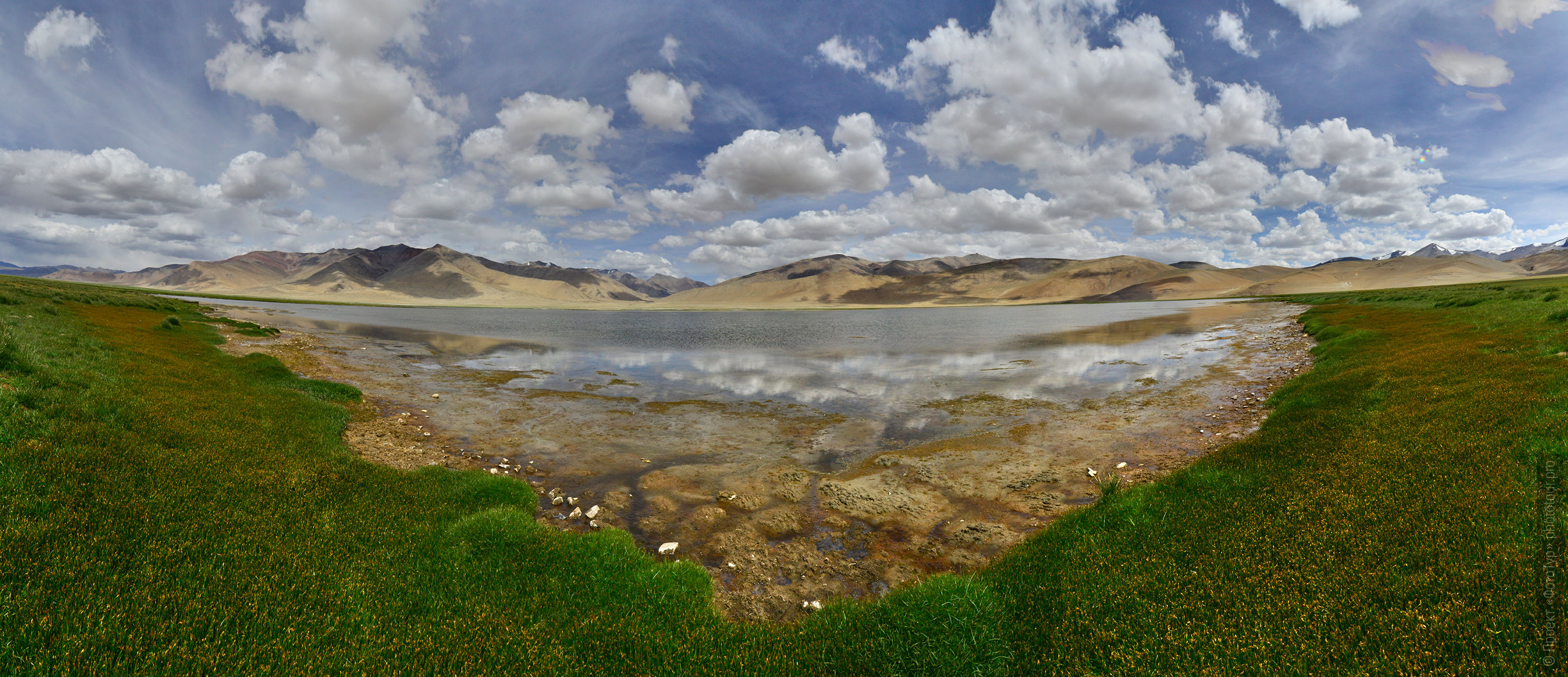The Booking of your participation in any journey takes place in three stages:
First step: Filling the application form for participation in the tour. Be sure to include your full name, We work officially and all accounts are registered. Please write your contact so that we have the communication wit you. After your application come to our website - the site administrator will send you a bill at your name for a advance of the tour. Maximum response time: 6 hours. Usually responsible for 1 hour.
Second stage: The reservation to participate in any tour takes place when you make the advance payment of 30% of the tour price to the account of an Indian travel company INCREDIBLE HIMALAYA. The advance is transferred via bank payment systems in any bank, account details will be sent by the administrator to e-mail of participants after getting the application form for participation.
ATTENTION Booking the tour takes place only when the advance payment transferred. If, after receiving of the invoice for advance payment, you do not make a payment within three working days, your application form for participation is automatically canceled by site. If you still want to participate in the tour, you have to apply the form again. When we receive an advance on our bank account we sent payment receipts confirming your participation, as well as a contract for the provision of travel services on this tour. The administrator sends you the electronic copies of receipts and contracts with digital signature and seal by e-mail and if necessary - to the postal address - the original documents. The remaining amount is payable as ayou arrive at the beginning of the trip, in India.
The third stage: Preparing for the journey. We also have a verbal communication on Skype with members of our travels. 2 weeks before the tour we gather the whole group in Skype and discuss preparations for the journey. Also welcome verbal individual consultations on Skype, it helps us to answer all your questions maximized. Because the most of the year we are in India, the main communication with us is Skype.
Attention! You don't need to register on our site to join the tour. If you are unable to fill the application form, please just send your application in letter (free form) - by mail: [email protected]
Attention! If you have not received a response to your letter within 6 hours (maximum response time for a request), please look at the spam folder. Perhaps, our letter got there by mistake. We always reply to requests in a maximally short period of time.
Expedition Tibet Lake-2: Pangong, Tso Moriri, Tso Kar, Tso Startsapak, Leh-Manali highway.
Day 1, July 20: Arrival in Delhi. Flight Delhi - Leh. Acclimatization. Meet with Leh.
Day 2, July 21: Walk through the valley of Ladakh. Buddhist monastery of Basgo Gonpa.
Day 3, July 22: Leh - Nubra Valley: Diskit Monastery, Lachung Temple and Gompa Khundur.
Day 4, July 23: Transfer Nubra - Lake Pangong. Village Tangtse. Monastery Sashikul Gonpa.
Day 5, July 24: Lake Pangong Tso.
Day 6, July 25: Lake Pangong - Lake Tso Moriri, the village of Karzok.
Day 7, July 26: Village Karzok. Lake Tso Moriri. Settlements nomads ChongPa.
Day 8, July 27: Lake Chiagar Tso. Valley of highland geysers - Lake Tso Kar.
Day 9,July 28: Lake Tso Kar, Lake Tso Startsapak (Tso Startsapuk).
Day 10, July 29: Lake Tso Kar - Rupshu valley - Tanglang La - Rumtse pass (Burgundy gorge)- Leh.
Day 11, July 30: Free day in Leh.
Day 12, July 31: Leh - Delhi (flight).
Excursion to Delhi (on request), in the evening transfer to the airport and return home.
Reservation of places for participation in the Tibet Lake-2 expedition takes place when the Indian travel company INCREDIBLE HIMALAYA PRIVATE LIMITED makes an advance payment of 150 USD to the account of the Indian travel company.
The advance is transferred by the participant of the expedition in Tibet with the help of payment banking systems in any bank, the details of the current account are sent by the administrator to the participant’s mail after receiving the application for participation in the trip.
When making an advance payment, a payment receipt is sent to the participant confirming the payment of money and the booking of your participation in the expedition, as well as an agreement on the provision of travel services for this tour.
The remaining amount is paid by the participant as they arrive at the start of the expedition, in this case, upon arrival in Leh, Ladakh, India.
1. Transfers from / to the airport to the hotel in Leh.
2. Movement along the entire route (from the ramp to the ramp) in comfortable cars.
3. Accommodation in double rooms in hotels, guest houses and campgrounds along the route of the expedition.
Accommodation in a single room, surcharge $ 302 for the entire route.
4. Information support by the organizers of the PhotoTour Project from the beginning to the end of the trip.
5. Excursion support of PhotoTour Project guides.
6. Guide-photographer and thematic consultations on travel photography, genre photography and photography in the highlands of Ladakh.
7. Lecture-introduction to the culture of Tibetan Buddhism.
8. Lecture on landscape photography in Ladakh: Features of landscape photography in Little Tibet.
9. All taxes and fees on the route of the expedition.
1. Flight to New Delhi Airport from the country of residence and back.
2. Flight Delhi - Leh - Delhi. Approximate airfare from $ 80 to $ 150.
3. Entrance fees to monasteries and monastic buildings, about $ 10 for the entire time (if at all).
4. The cost of permits to the closed and border zones of Lakes Pangong Tso and Tso Moriri and the Nubra Valley is about $ 20 per permit.
5. Tourist visa to India $ 100, processed online 7 days before arrival in India.
Information on registration of tourist visa to India.
6. Meals during the expedition: about $ 140 for the entire trip.
7. Medical insurance: issued by each member of the expedition individually at the place of residence.
8. Mandatory tips for tour drivers at the rate of $ 1 per day per participant.
9. All that is not listed in the list "In the price is included."
Expedition-photo tour "Tibet-Lake-2" is designed for photographers and travelers from the world.
ATTENTION!
This trip has no special requirements for physical condition and health:
the level of health is not below average and the absence of chronic systemic diseases.
You should also not worry about high-altitude acclimatization:
we can acclimatize and, almost all of our tourists, easily tolerate the climate and altitude of Ladakh.
The tour has age restrictions: from 18 years to 65 years.
BOOKING FOR PARTICIPATION IN THE EXPEDITION TIBET OF LAKE-2 IS POSSIBLE BEFORE 01 JULY 2024.
But entry into the expedition can be stopped earlier - as soon as a group of 10 people is recruited.
If you want to go to the photo tour of Tibet Lake, please book in advance places to participate.
The minimum number of participants in the group of this trip is 10 people.
The maximum number of participants in the group of this trip is 10 people.
The journey is calculated at a comfortable level.
In Leh: a cozy warm hotel with hot water, with a bathroom and toilet in the room, wi-fi in the room.
On the lake Pangong Tso: a hotel with amenities, with bathroom and toilet in the room.
In the village of Karzok, Lake Tso Moriri: a luxury hotel overlooking the lake, toilet and shower in the room, hot water, occasionally wi-fi in the room.
On the lake Tso Kar: camping, facilities in the yard.
In the village of Rūmce: guest house with minimal amenities, nothing else is not here.
In the village of Diskit, Nubra: a hotel with hot water, with a bathroom and toilet in the room.
For those who want to ask questions about the organization and participation in the Tibet Lake 2 expedition, please contact us:
Phones for communication:
+ 91 94 1909 7049 (India) - Telegram and WhatsApp - Ilona Kryzhanovskaya, head of INCREDIBLE HIMALAYA and the PhotoTour Project.
+ 7 9037204771 (Russia) - Maxim Savchenko, technical director of the PhotoTour Project.
Facebook messenger:
Ilona Kryzhanovskaya - administrative questions regarding the tour, advice on purchasing air tickets, you can write and call via messenger.
e-mail:
[email protected] - Ilona Kryzhanovskaya, head of the PhotoTour Project
[email protected] - Maxim Savchenko, PhotoTour Project
On travel Tibet Lake-2 a team of organizers works:
Ilona Kryzhanovskaya: photographer, ethnographer, ethnographic photography, genre photography, subcultural practices, the construction of a myth in photography.
Maxim Savchenko, Technical Director of the PhotoTour Project, Moscow.
Sonam Rinchen is a partner and co-founder of PhotoTour Project.
Otzer Rinchen: head of the team of project photo tour guides.
Nina Lozenko: Director-Administrator of the PhotoTour Project.
Our local Ladakh culture guides, PhotoTour Project team.
A team of driver guides along the whole photo tour route.
For participants in the photo tour Lakes of Tibet is recommended to obligatory reading:
Guidelines and rules for travelers in Ladakh, Zanskar and Spiti (Little Tibet).
In terms of individual preparation for taking pictures on the photo tour Lakes of Tibet we recommend to read the following articles:
View photos of the lake Tso Moriri.
View photos of the lake Tso Kar.
View photos of Lake Pangong Tso.
View photos from our photo tours to Tibet.
July photo tour around the lakes in Little Tibet, 2012.
July 2013: passed and ended July photo tour on the lakes of Little Tibet: Pangong Tso, Tso Kar Tso Moriri.
July 2014: Photos from the tour around Tibetan Lakes, July 2014.
Passed and ended the advertising photo tour Lakes of Tibet-2, 15.08. - 08.26.2013 year.
Passed and ended the advertising photo tour Lake of Tibet-2: Highland Lakes, Valley of Geysers, 17 - 26.08.2014 year.
Sergey Pobegaev: the movie "Ladakh" at the end of the photo tour Tibet Lake, July 2014.
In 2023, the photo tour of Tibet-Lake-2 will be held in the format of the expedition for photographers.
Why is the expedition format chosen and what does it mean?
Because we will go from Leh along a large circular route, covering the most remote and spectacular corners of Ladakh, which have a very limited number of tourists.
We will drive along a very large circle, along very difficult roads, along the back streets of Ladakh.
Do I need to explain why this format was chosen?
The answer to the surface: because it is very interesting and fantastically beautiful ..
ACCENT OF TRAVEL: ARTISTIC PHOTOGRAPHY OF HIGH-MOUNTAIN LAKES LADAKH.
The photo tour will be very interesting for photographers of any level - from pros to amateurs, and just for active tourists.
For professional photographers, this trip is a great opportunity to collect material for an individual exhibition.
For amateur photographers - this is a good practical school of continuous photography in places where you can take pictures around the clock.
For tourists, this is an incredible journey, which you will not find any analogues with more than one tour operator. And, as a bonus, learn the basics of travel photos.
This trip to the mountainous lakes of Little Tibet was a hit of the seasons of 2012-2019 and is objectively the most spectacular and vibrant photo tour of Ladakh.
This year we expanded the photo tour program by adding photography on the lakes - Tso Starpak and Chiagar Tso, as well as a shooting day on the Leh-Manali highway - the highest mountain in the world and an amazingly beautiful road and the Nubra valley, as well as the road from the valley closed until 2017 Nubra on Lake Pangong.
Moreover: the photo tour program Tibet Ozerny is extremely saturated - for 14 days there is not a single day off, all days will be extremely filled with photography.
And emotions.
Among other things, this trip is an opportunity to emotionally relax and energetically recover in a good interesting company.
The places we will travel to are considered to be sacred places and places of power in Ladakh.
Key highlights of this trip:
1. Five high-mountainous lakes in Ladakh (Small Tibet): Pangong Tso, Tso Kar, Tso Moriri, Tso Startsapak and Chiagar Tso are not just beautiful places, the places are fantastic.
2. Valley of high-mountain geysers between lakes Tso Moriri and Tso Kar.
3. Remote villages of high-mountain nomads-shepherds of the Ladakhi people of Chongpa.
4. Leh-Manali Highway: the Grand Canyon, the incredible beauty of the mountain - the path to the heart of a stone flower in the literal sense of the word.
5. Ethnographic photography in Buddhist monasteries in Ladakh.
6. The highest road pass in the world of Kardungla and the Nubra Valley.
7. Free photography: the tour program is structured in such a way that participants can take pictures during the modal time on an individual schedule.
And according to its program, a photo tour is as close as possible to an individual journey: a small group of only 10 people.
And most importantly:
LAKES AND ADVENTURES WILL BE MUCH!
Photos shown in the description of the expedition Tibet Lake-2 are clickable to large size, just click on the photo and it will open in a new window.
All photos are taken by us and are a real display of the places we visit, and at the time we go there.
The description of each day of the tour indicates the total mileage per day and the height of the visited places.
Day 1, July 20: Arrival in Delhi. Flight Delhi - Leh. Acclimatization. Acquaintance with Leh, height 3,600 m.
Arrival at New Delhi International Airport (India) from the country of residence.
We issue an electronic visa, get the luggage and go to one of the terminals of local airlines:
D3 is in the same building
D2 - a little further, you have to turn left from the terminal building of international airlines and walk 100 m through the tunnel.
This is a common practice on our Ladakh tours:
Flights on which members of our tours arrive at Delhi Airport usually arrive at terminal D3 from 2 to 5 am, immediately go to the departure terminal and fly to Leh on one of the morning flights.
Flights for Delhi - Leh take, so that the time margin between the external and internal flights is 3-4 hours.
Flight to Leh, 1 hour 20 minutes.
This hour and a half flight Delhi-Leh is a spectacular sight, the plane flies over the beautiful peaks of the Himalayas.
We recommend to book in advance the seats on the left side of the aircraft - when landing in Leh, this side is the most filming, and the best places are from 27 to 30, so the wing of the plane will not interfere.
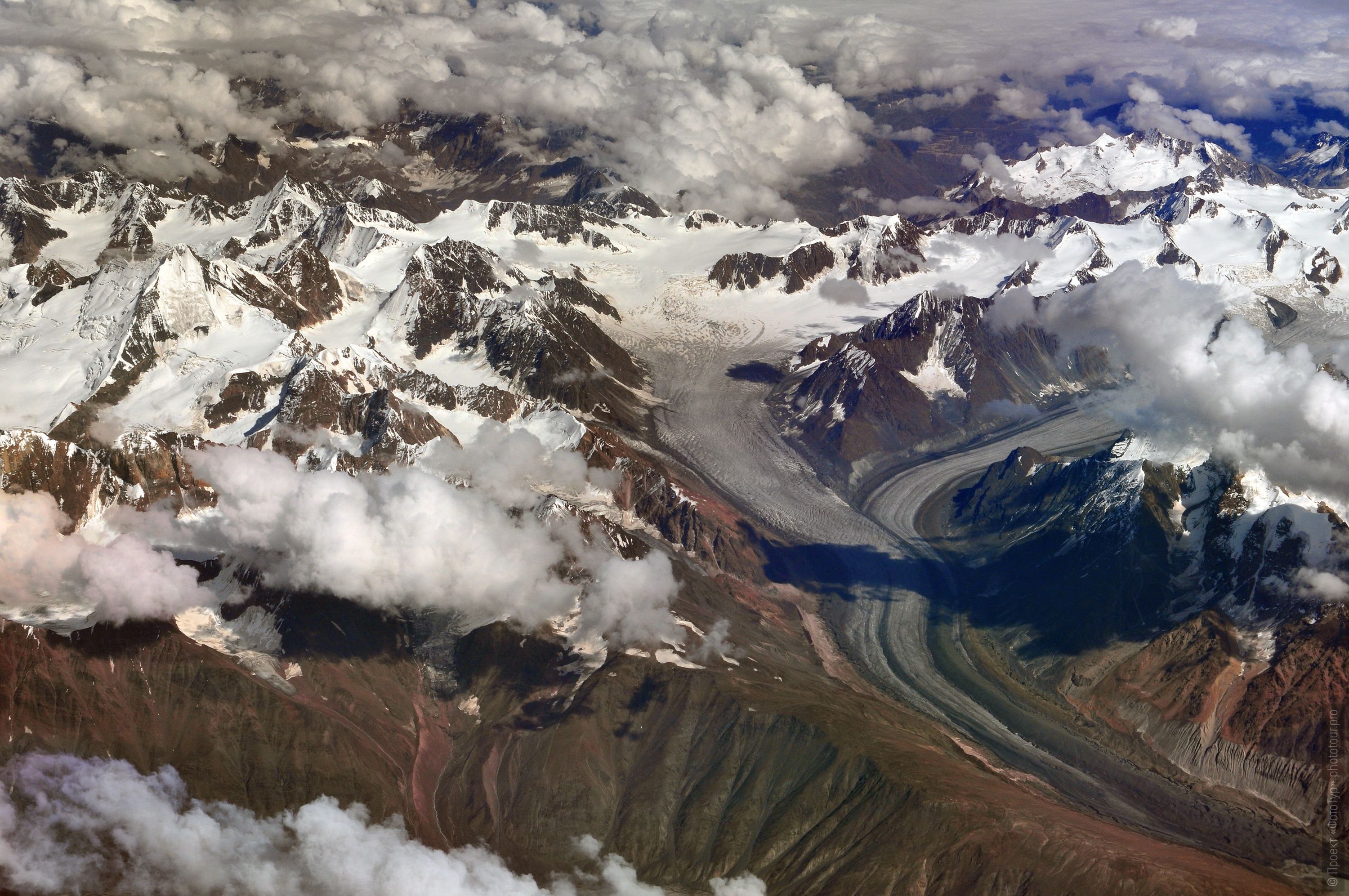
The plane literally sneaks and moves through the gorge in the middle of the mountain ranges.
From the height we will see for the first time the lakes of Ladakh, to which our entire journey is drawn, for example, the majestic salt lake Tso Kar and very close (on the left in the picture) is the freshwater lake Tso Startsapak:
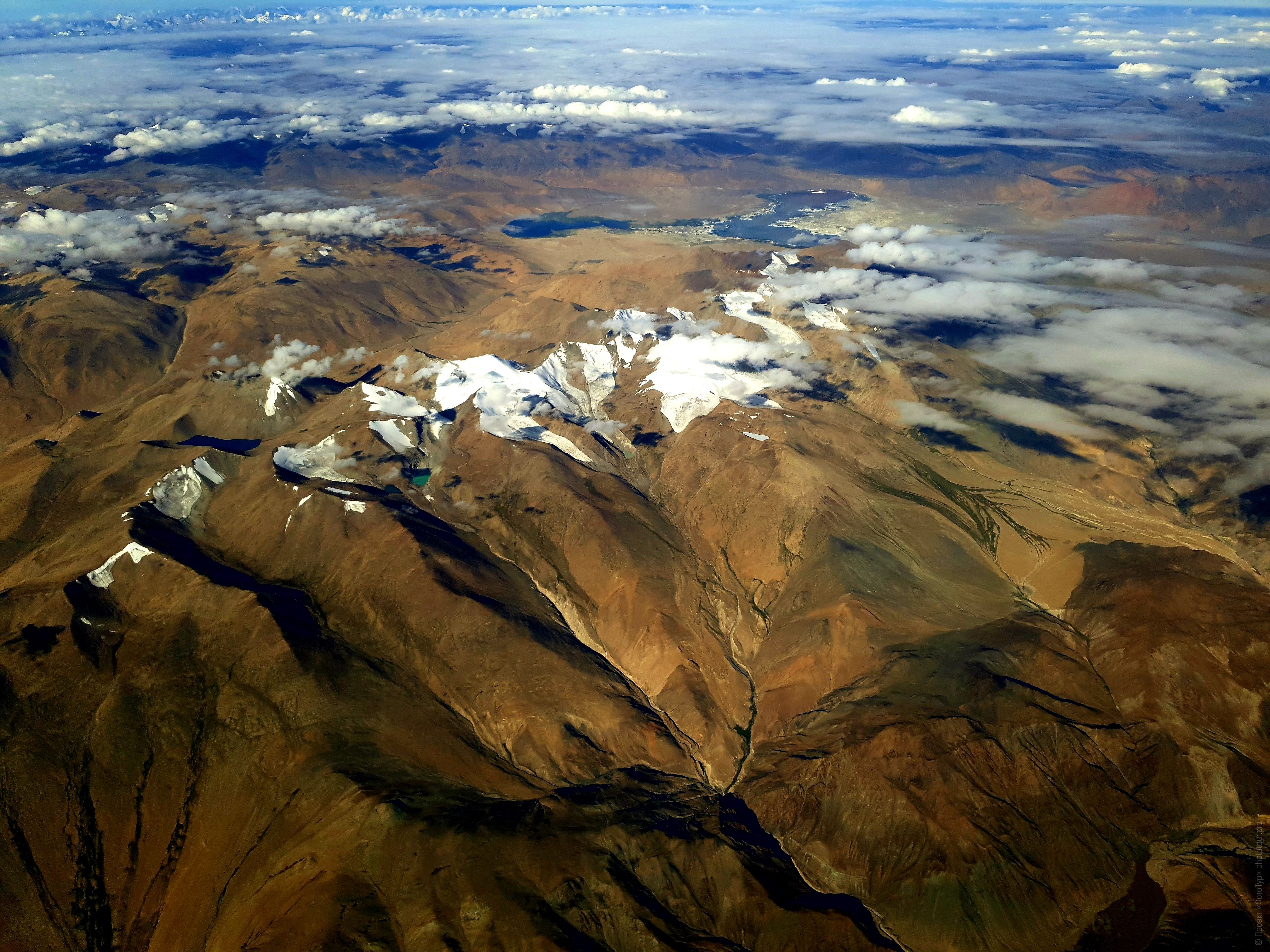
Unfolding below us and incredibly bright, rich pictures of the mountains of Leh-Manali Highway, on which we will then drive to the Grand Canyon along this very thread-road:
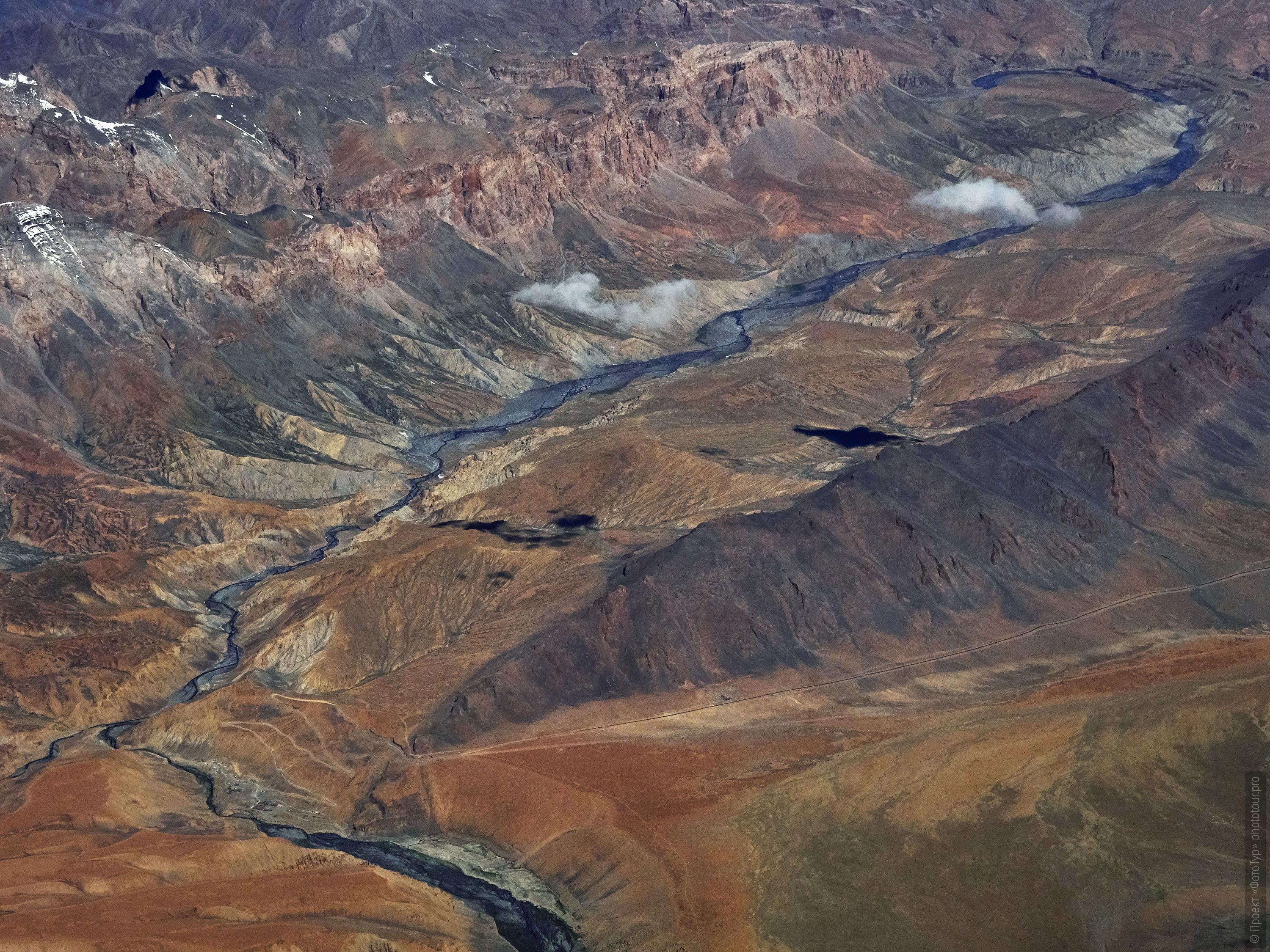
It should be noted that for photography during the flight the most convenient lens will be 24-70 mm:
the plane flies inside the gorge, practically among the mountains, and if you take the telephoto main lens, you will be able to shoot only small fragments.
With a 24-70 mm lens, the frame will look something like this:
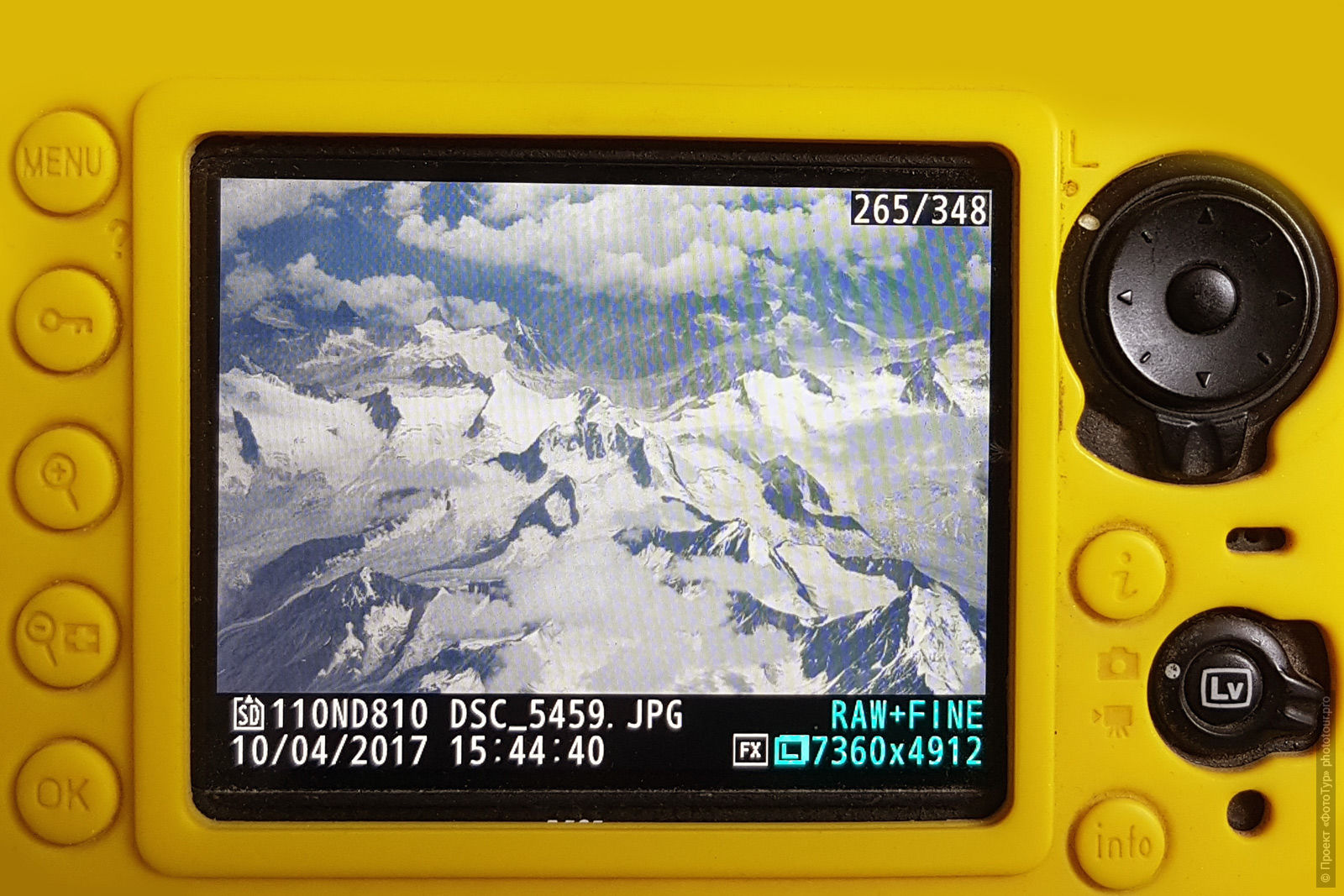
And, by the way, just before Leh, another bonus of photography during the flight is the purple-burgundy mountains of the Hemis natural reserve:

We arrive in Ladakh, the plane makes a beautiful turn over the valley (a great time for photography) and lands at the only airport in the valley - in the city of Leh.
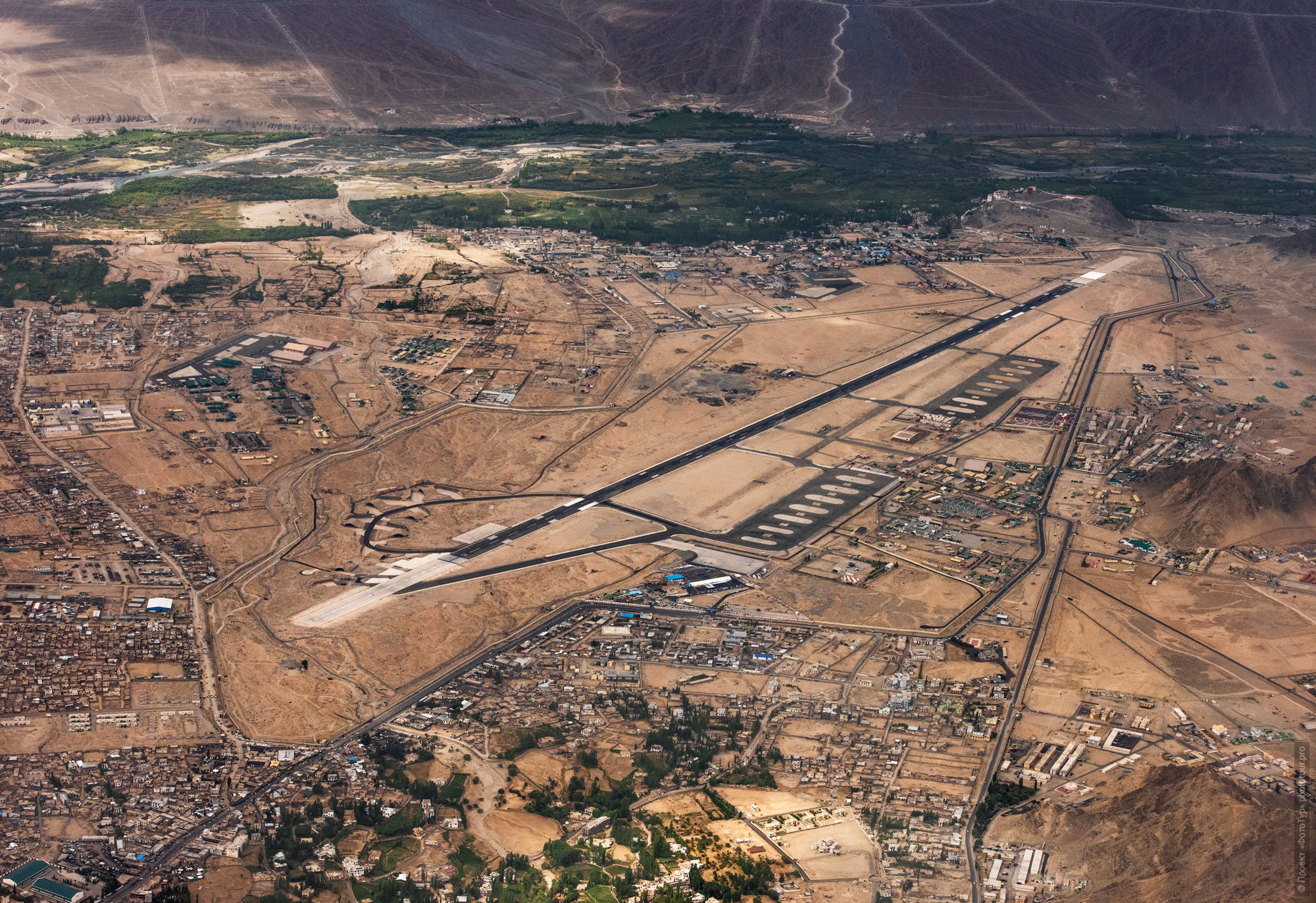
Transfer to the hotel, breakfast.
Leh is at an altitude of 3600 m.
And on the first day of the photo tour it is very important for the participants to undergo the correct high-altitude acclimatization: we are instructed in acclimatization, we drink a lot of fluids, and after the first hours we arrive at the hotel.
After an acclimatization holiday at the hotel, we go on an unhurried adaptation walk in the center of Leh to the Main Market:
get acquainted with the infrastructure of the city, walking along the main street of the city.

We will finish the walk in the wonderful Penguin cafe-restaurant (yes, it is Penguin), where our first dinner will be held in Leh.
In the evening, a lecture on the introduction of the culture and customs of Tibetan Buddhism.
Hotel in Leh.
Day 2, July 21: Walk through the valley of Ladakh. Buddhist monastery of Basgo Gonpa, about 60 km, 3 400m.
This morning we set off for our first car acclimatization walk in the Ladakh valley, to the beautiful Buddhist monastery of Basgo Gonpa.
On the way, incredible landscapes await us, such as this place where the Indus and Zanskar rivers merge.
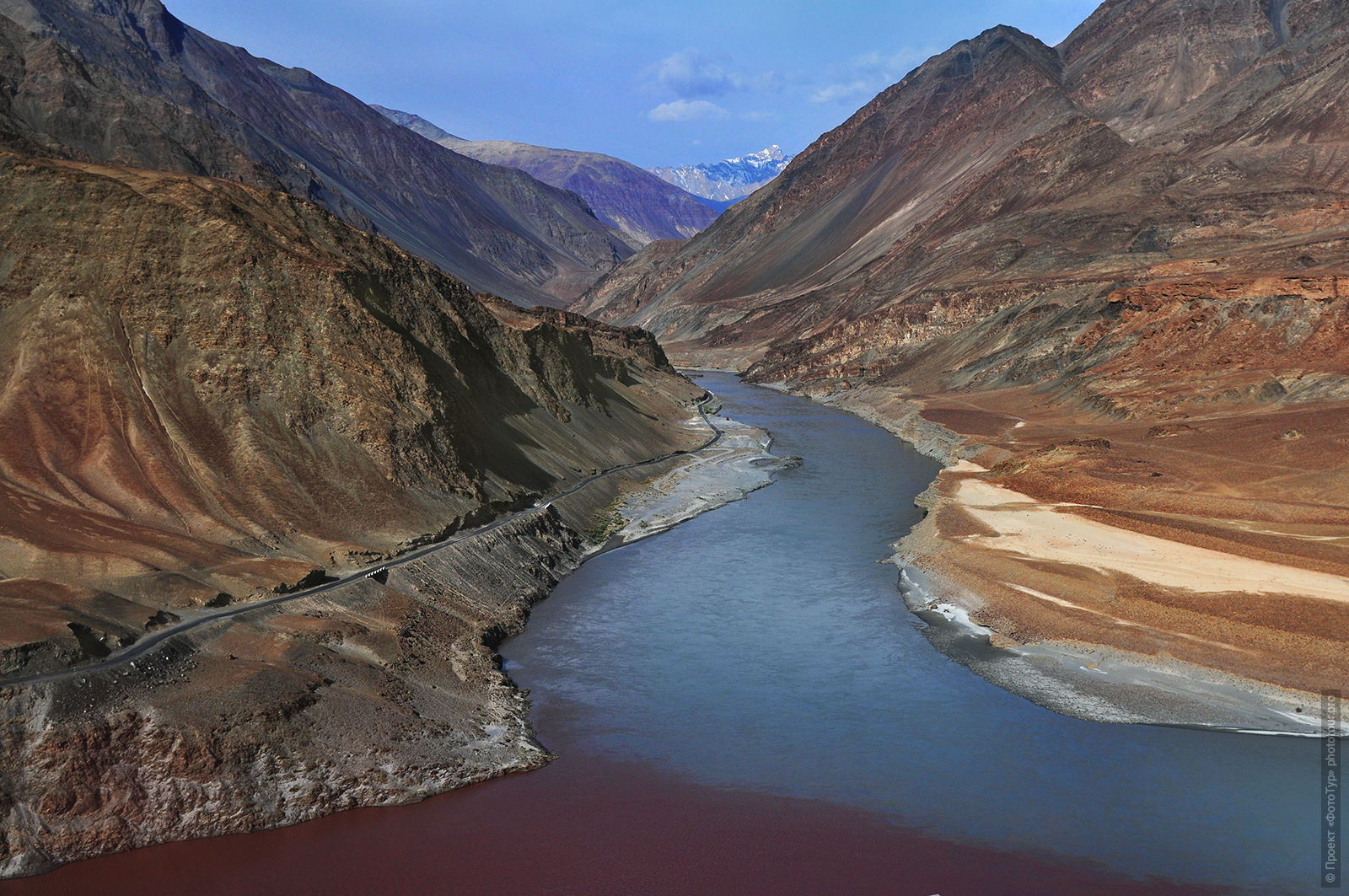
The observation deck on the valley of Basgo - it is there to the monastery of Basgo Gonpa that we are heading today:
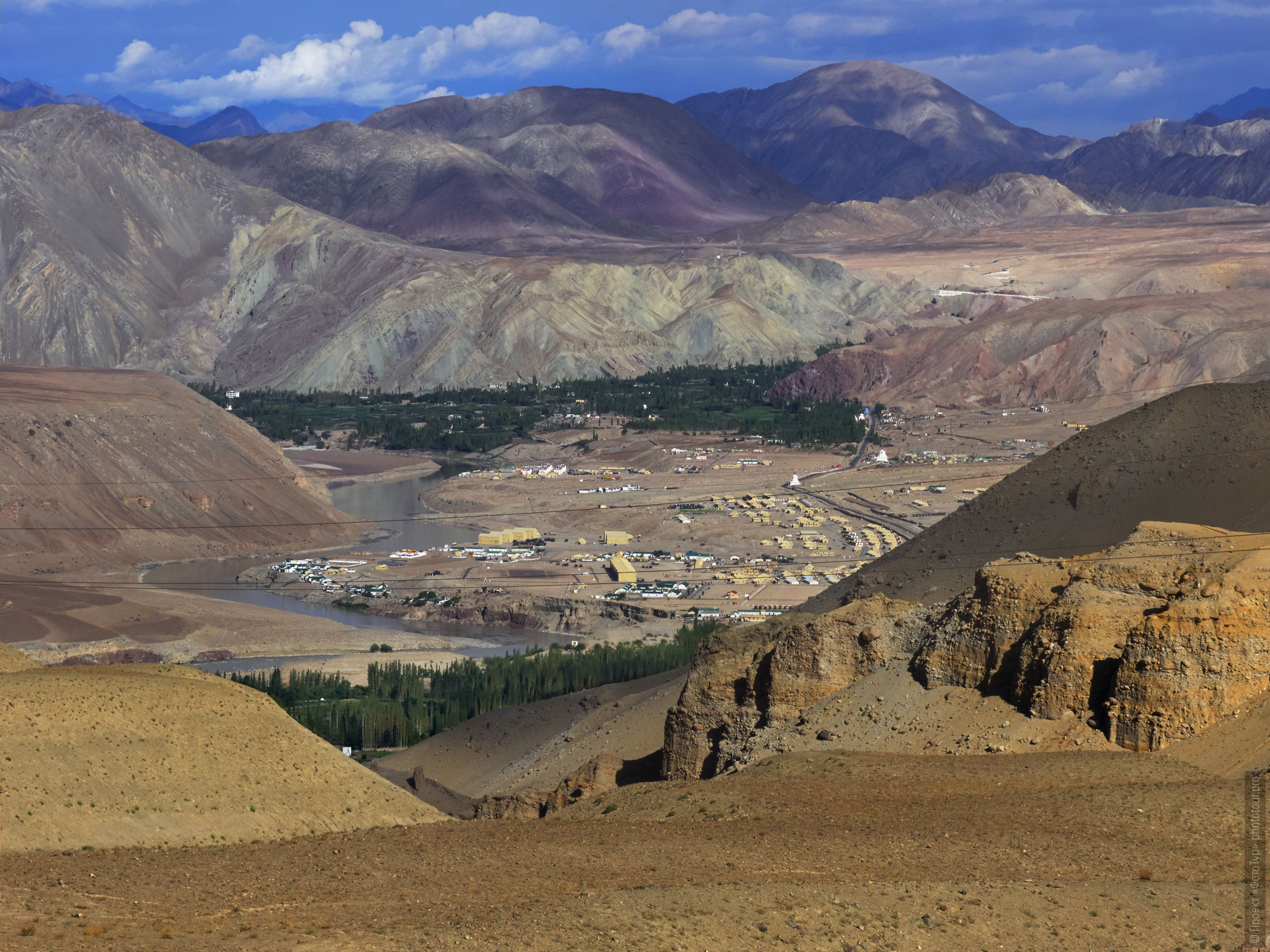
In general, the whole valley of the middle course of the Indus River is very unusual:
here the mountains are colorful, bright saturated colors - burgundy, green, red, purple, yellow - and all this beauty is mixed in almost vertical mountain folds.
The rocks themselves are quite soft - sandstones, shale, which allowed the processes of weathering for thousands of years to create incredible landforms here.
And in the midst of all this - white Buddhist stupas.
Impressive.
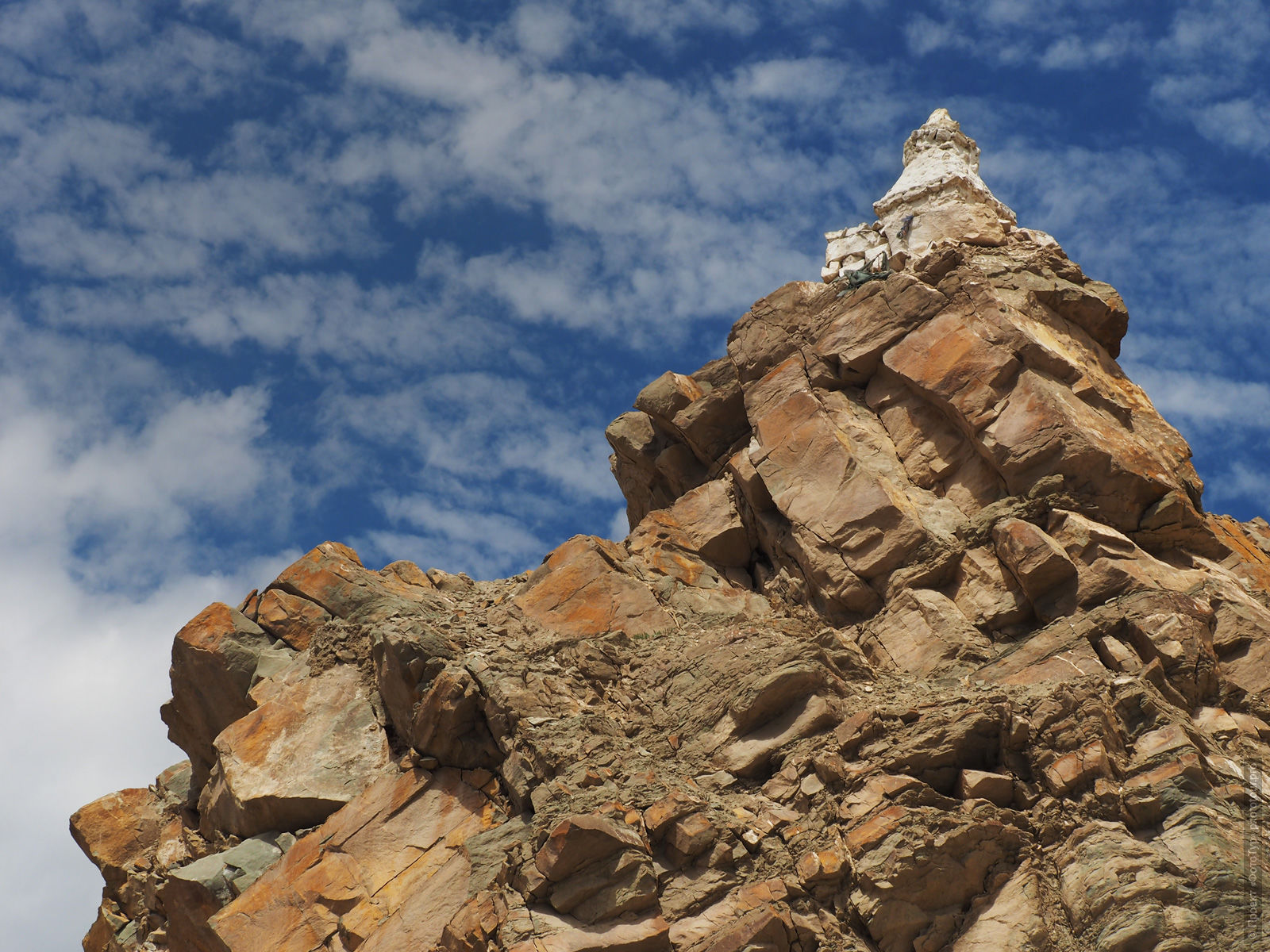
With numerous stops we get to the village of Nimo:
in the village of Nimo, in the local tavern, we will try real Ladakhi food - very tasty: samosas and tampa air cakes with boiled peas in small bowls.
Nima is very tasty, people from all over the valley flock to this tavern, and in the tavern you can meet a lot of wonderful characters - here and from all around are flocking for lunch and road workers and just locals.
And you can safely photograph these portraits here, for example:

And after lunch - we will continue our journey to the Buddhist monastery of Basgo Gonpa.
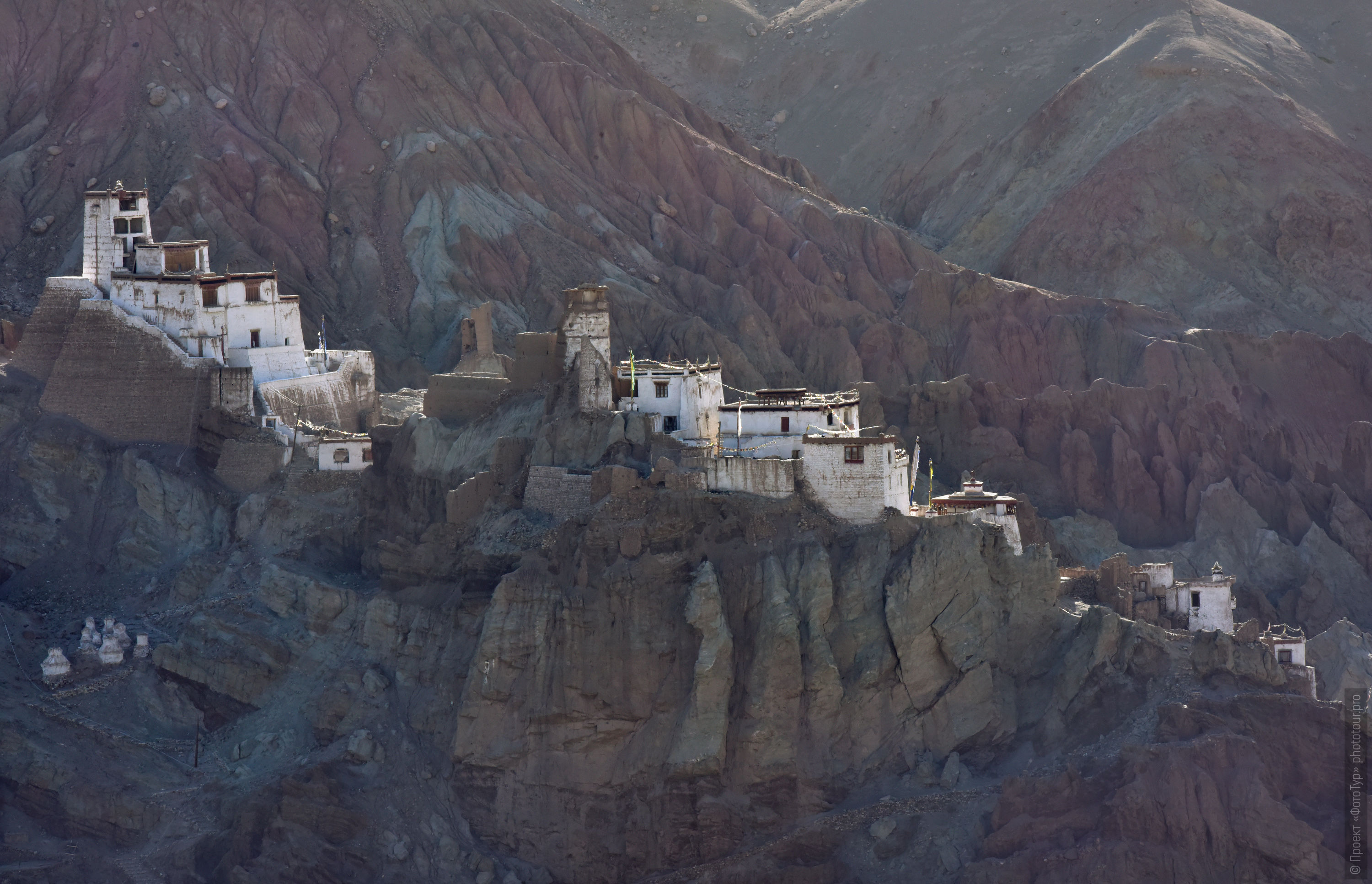
Buddhist Monastery of Basgo, Basgo Gompa - built in 1680 by the rulers of the Buddhist dynasty Namgyal.
The village of Basgo itself has been known since antiquity and is mentioned in the Ladakh Chronicles as a political and cultural center and the former capital of Lower Ladakh.
The monastery is famous for the unique frescoes of the XVI century and the statue of Buddha Matreyi:
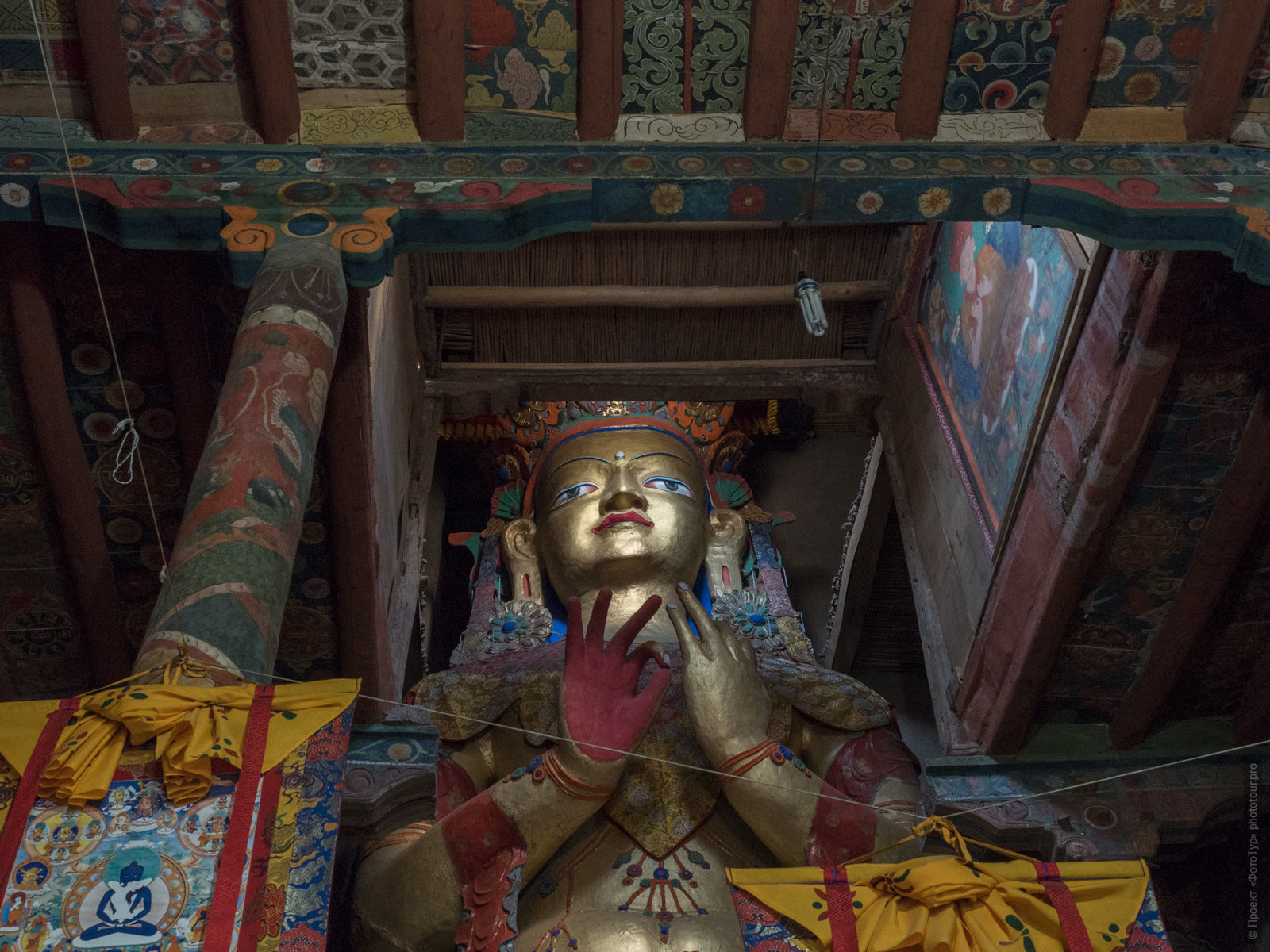
Basgo Gompa stands on steep rocks, no, probably more correct this way:
Basgo Gonpa as it grew on the tops of steep cliffs, which really are part of its foundation and literally hangs - floating in the air above the village of Basgo.
It is very curious to observe and photograph the village itself from above - from the observation platforms of the monastery:

The landscapes on the territory of the Basgo Gonpa nature reserve are simply incredible - there is no other word for it:
the bizarre-shaped rocks stand interspersed with the buildings of the monastery, and are interconnected not by tracks, but by steep mountain paths.
And in the midst of this rugged landscape - in the hollows of colorful lakes and natural phallic idols.
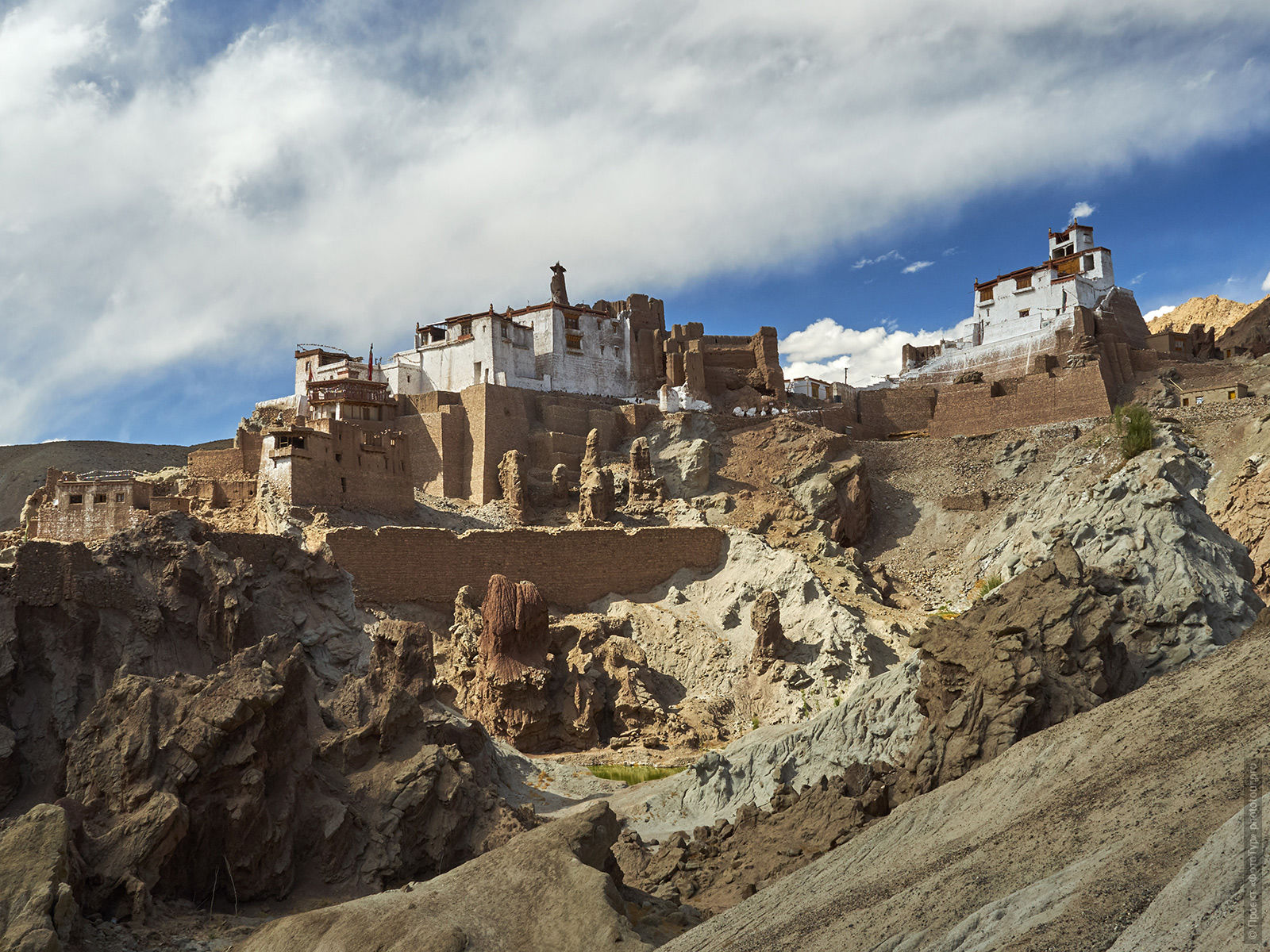
Here it is infinitely beautiful: probably, Basgo Gonpa is the most unusual Buddhist monastery in Ladakh.
Located Basgo Gonpa in steep burgundy rocks, the territory of the monastery itself is a completely incredible landscapes.
You can wander here indefinitely.
What we do.
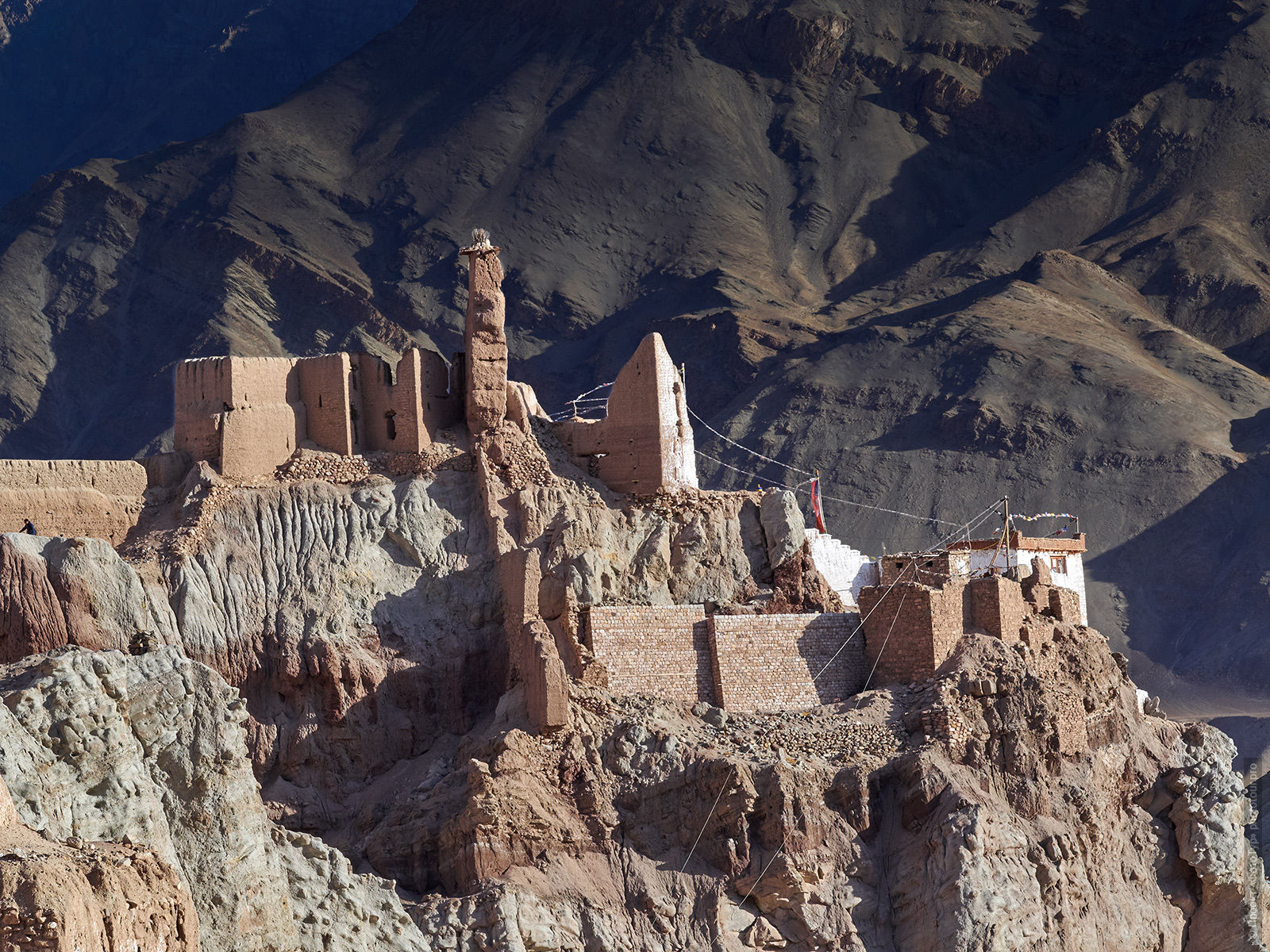
The reserved territory of the monastery is very large and there really is where to turn in terms of photography:
it is not by chance that Bollywood constantly shoots here).

In the evening we go back to Leh with numerous stops:
in the evening light, the Basgo valley is especially beautiful.
Hotel in Leh.
Day 3, July 22: Leh - Nubra Valley: Disket Monastery, Lachung Temple and Gompa Khundur, about 128 km, altitude 3,600 m (Leh) - 5,613 m (Kardung La Pass) - 2,800 m (Nubra Valley).
After an early breakfast we go to the Nubra valley.
We have to drive about 130 km, spend 5-6 hours on the road (Khardong La Pass - the highest pass in the world).
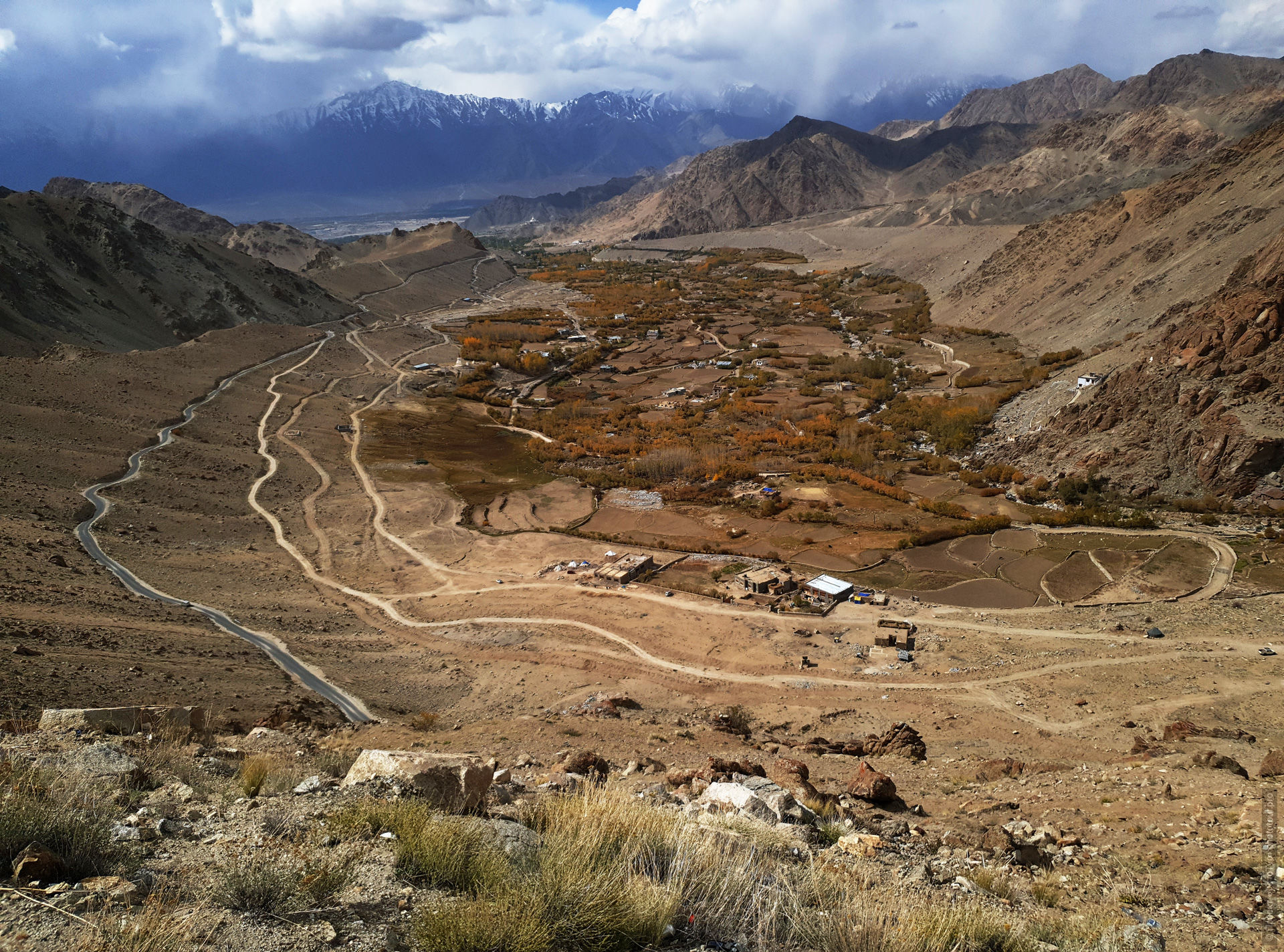
On this day we will stop a lot on the way for landscape photography - the road goes along the beautiful riverbed.

The Nubra Valley is undoubtedly one of the most beautiful in Ladakh.
It is located north of Leh, between the Ladakh and Karakoram mountain ranges.
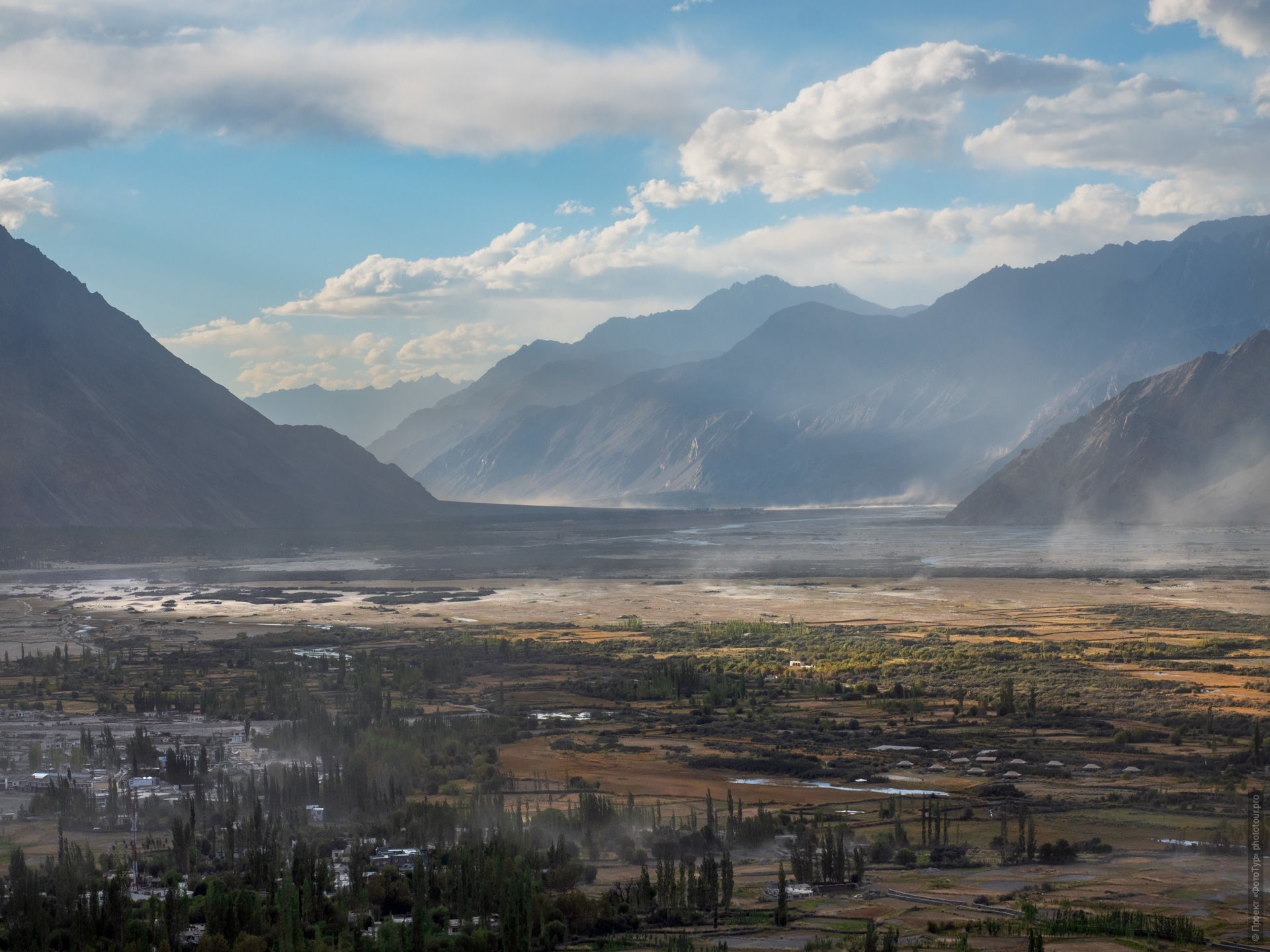
High mountains, long tongues of glaciers, sands, apricot orchards - all this creates a magical reality.
Here (in case of good weather) we will be able to see the highest peak of Ladakh - Saser Kangri, height 7670 m.
The name Nubra literally means "valley of flowers".
You can get into it by overcoming the Khardong La Pass (5600 m), the highest mountain pass in the world through which the Guinness Book of Records is laid.
The valley was once part of the Central Asian route known as the Silk Road.
On it passed the road connecting Leh with Yarkand and further to Central Asia and Mongolia.
Pilgrims to Mecca and Medina for the hajj also walked along this path.
Traditional trade was only stopped here in the 1950s, when Tibet was conquered by China.
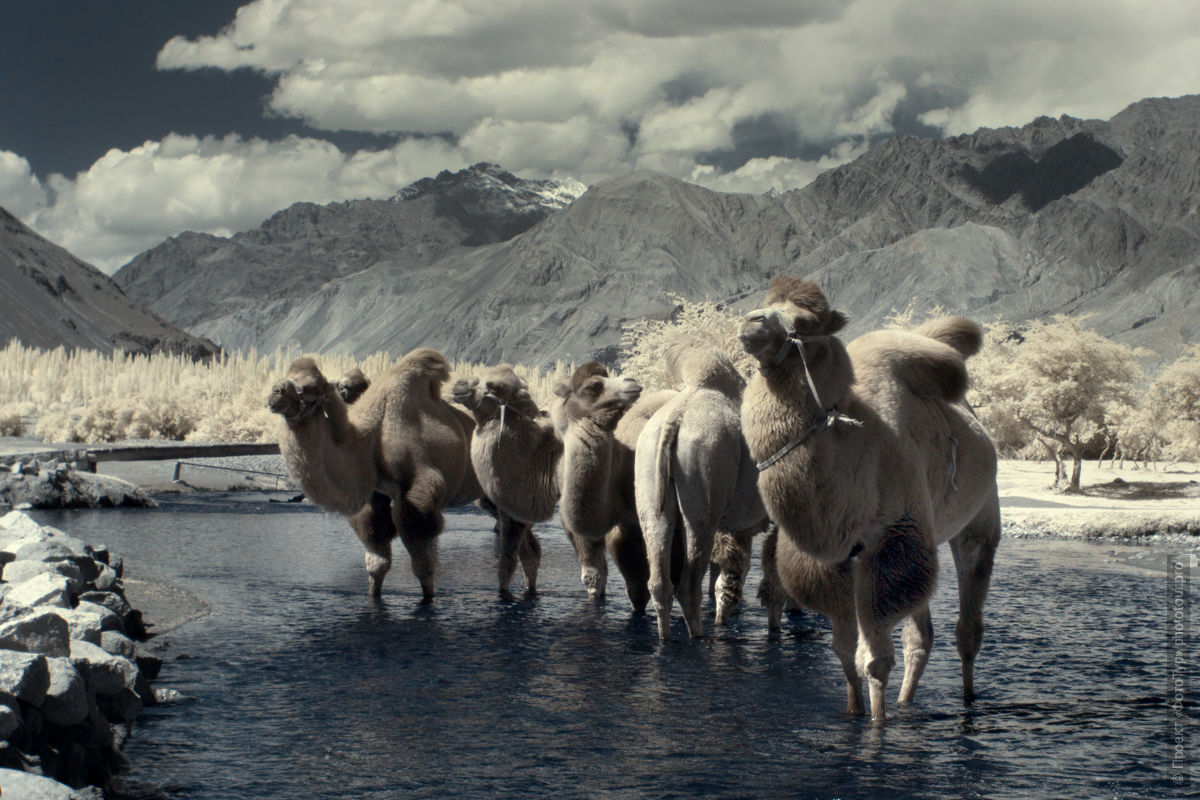
Villages scattered throughout the valley with green gardens and fertile fields, wide floods of the Shayok and Nubra rivers, sand dunes and camels, leisurely walking along them, hot springs, the rainbow colors of the Himalayas and the bottomless turquoise sky make this valley a truly fantastic country. Here, nature itself has created excellent conditions for growing apricots, apples and sea buckthorn.
And the sunsets here seep gold.
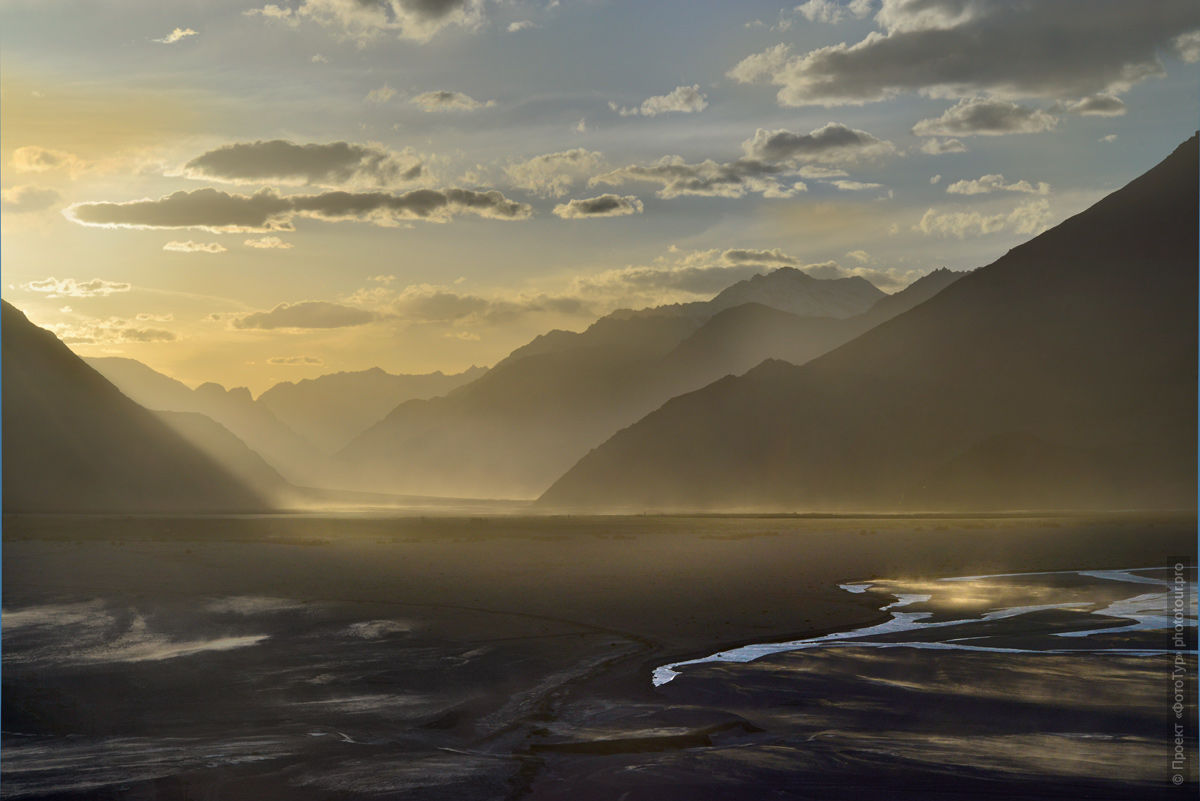
We will spend the second half of the day in the Buddhist Monastery Diskit, Lachung Temple and Gompu Khundur.
Monastery Diskit is essentially a temple town, surrounded by small ethnic villages.
Diskit Gompa or Disc Gomapa or Monastery Diskit - the oldest and largest Buddhist monastery in the Nubra Valley.

Monastery Diskit refers to the Gelug school of Tibetan Buddhism. Gompa was founded by Changzem Cerab Zangpo, a disciple of Tsongkhapa, the founder of Gelug.
The monastery was originally subordinate to Tiksi Gompa.
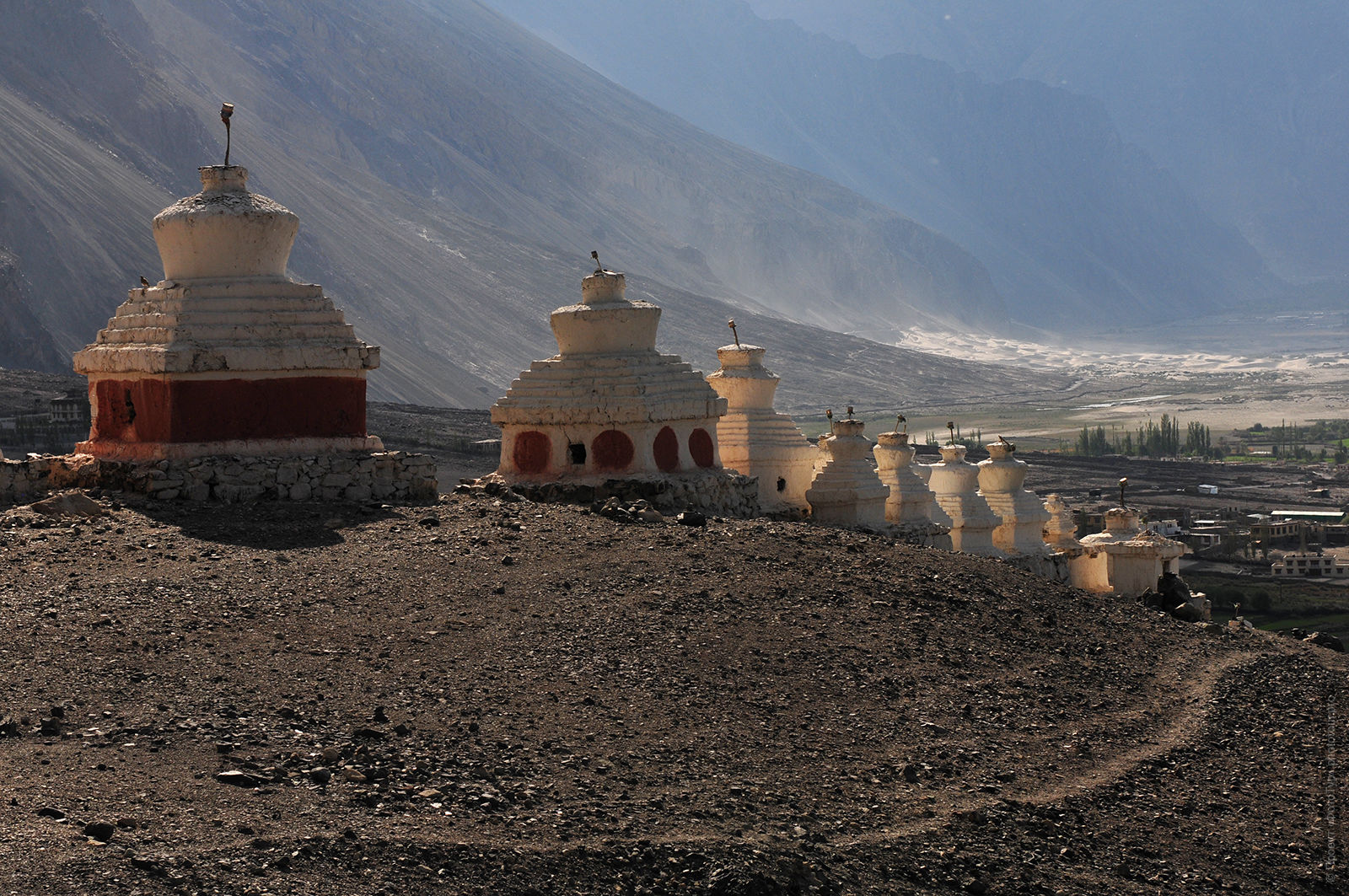
The Lachung Temple and Khundur Gompa are located nearby, the latter is lower down the road across the bridge.
In the monastery is a statue of Maitreya in the prayer hall, a huge prayer drum and images of the defenders of the teachings.
The domed dome of the monastery is covered with frescoes from Tashilhunpo in Tibet.
The monastery complex is the largest and most beautiful.
By the way, it was in these places, by giving to 33 years, that Jesus Christ spent his years.
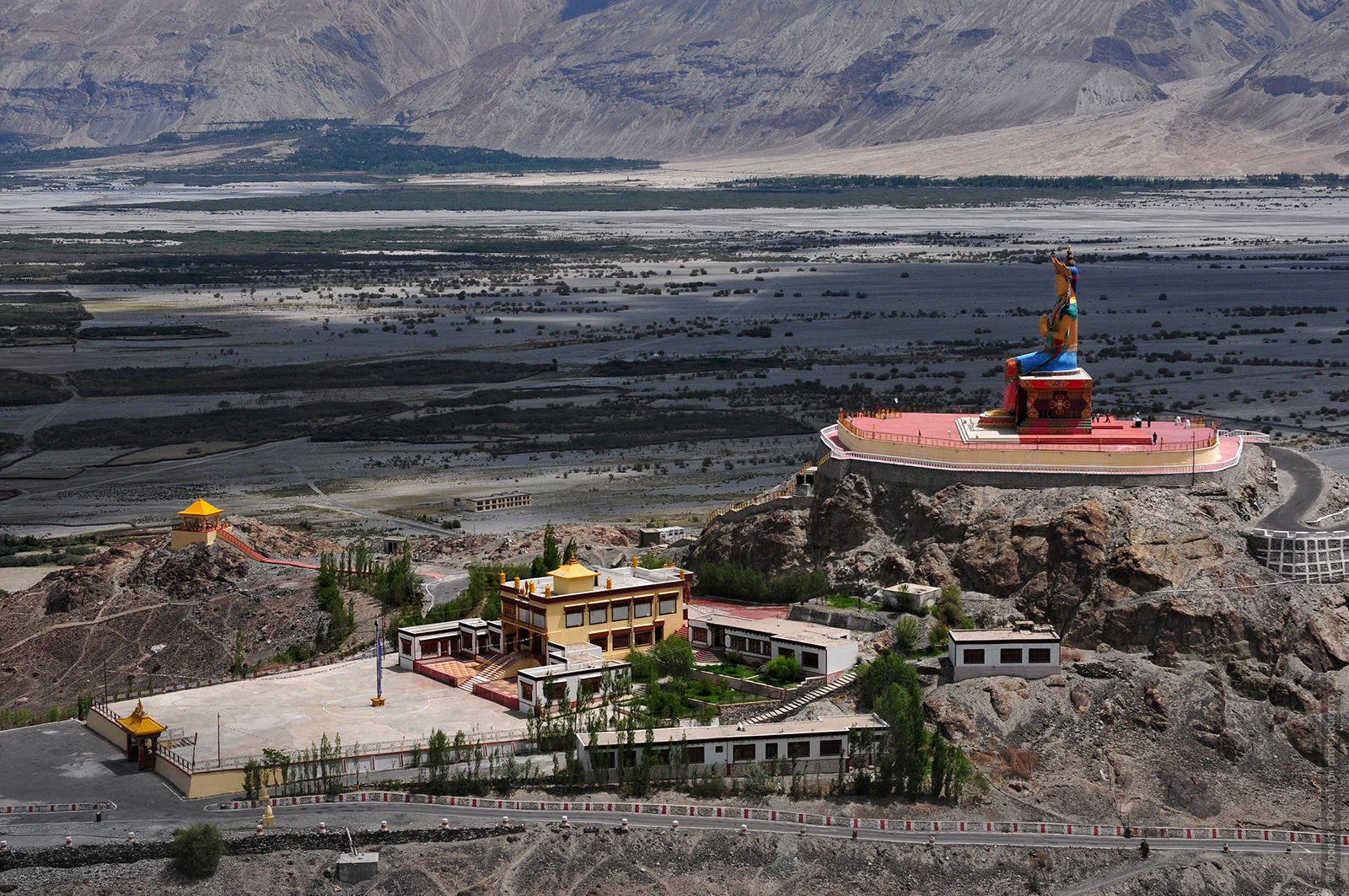
In the evening we return to our cozy hotel, rest.
Hotel in Diskyte.
Day 4, July 23: Transfer Nubra - Lake Pangong. Village Tangtse. Monastery Sashikul Gonpa, about 120 km, height from 2 800 m (Nubra) to 4 000 (Tangtse).
Morning photography in the Nubra Valley, along the lake with mirror reflections.
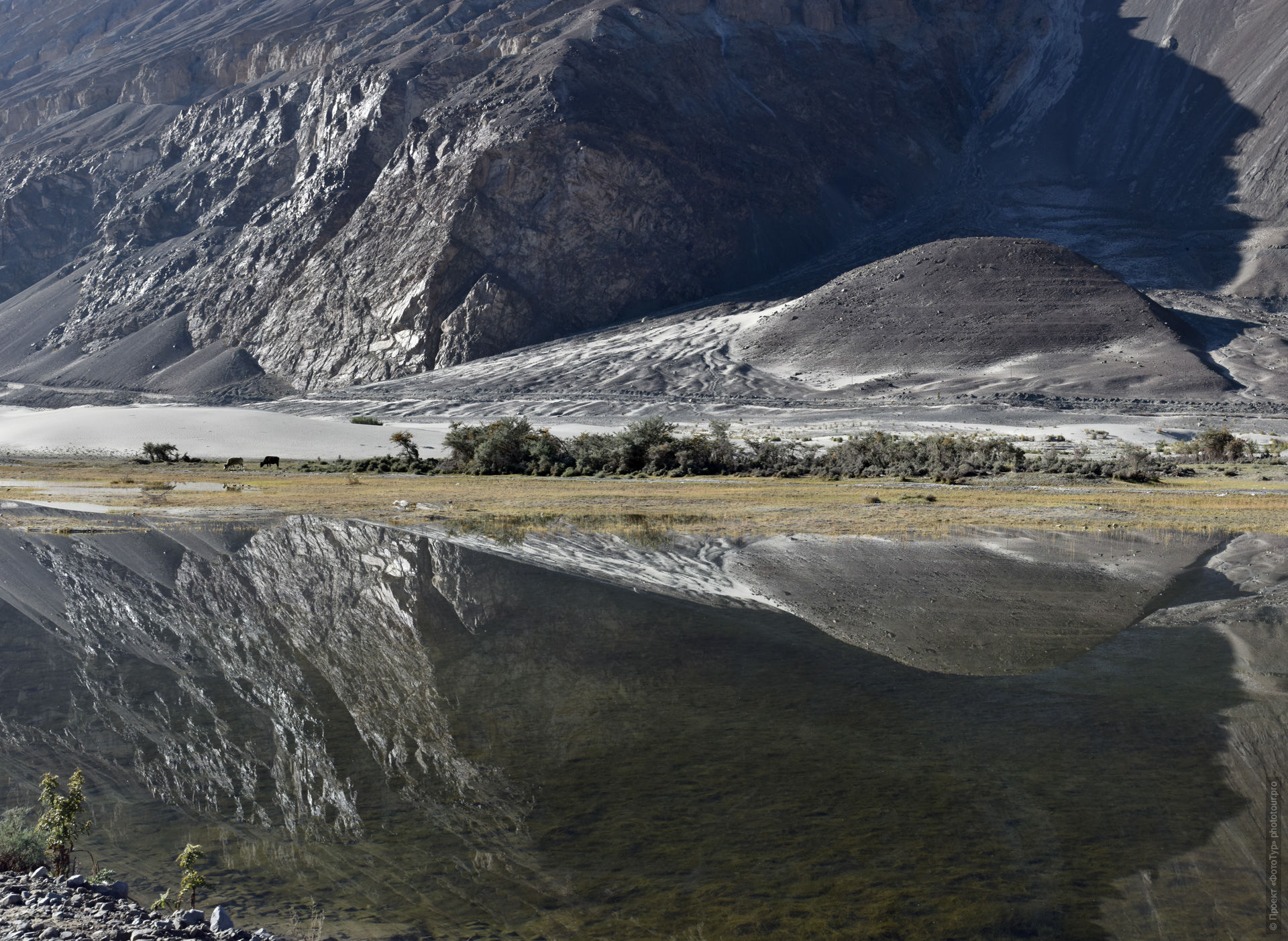
On this day, we literally have to be pioneers:
We will go from the Nubra Valley to Lake Pangong along the road, which was first opened to foreign tourists in June 2017.
All - absolutely crazy landscapes, remote villages.
In the evening, we arrive at the mountain village of Tangse and attend evening puja at the Buddhist monastery Sashikul Gonpa.
Near the village of Tangse, we turn into a side canyon and visit the Buddhist monastery Sachukul Gonpa, located in a very unusual place:
the rocky mountain outcrops surrounding the monastery are brightly striped, while Gonpa itself dates back to the 14th century.
The place is usually not visited by tourists due to its remoteness.
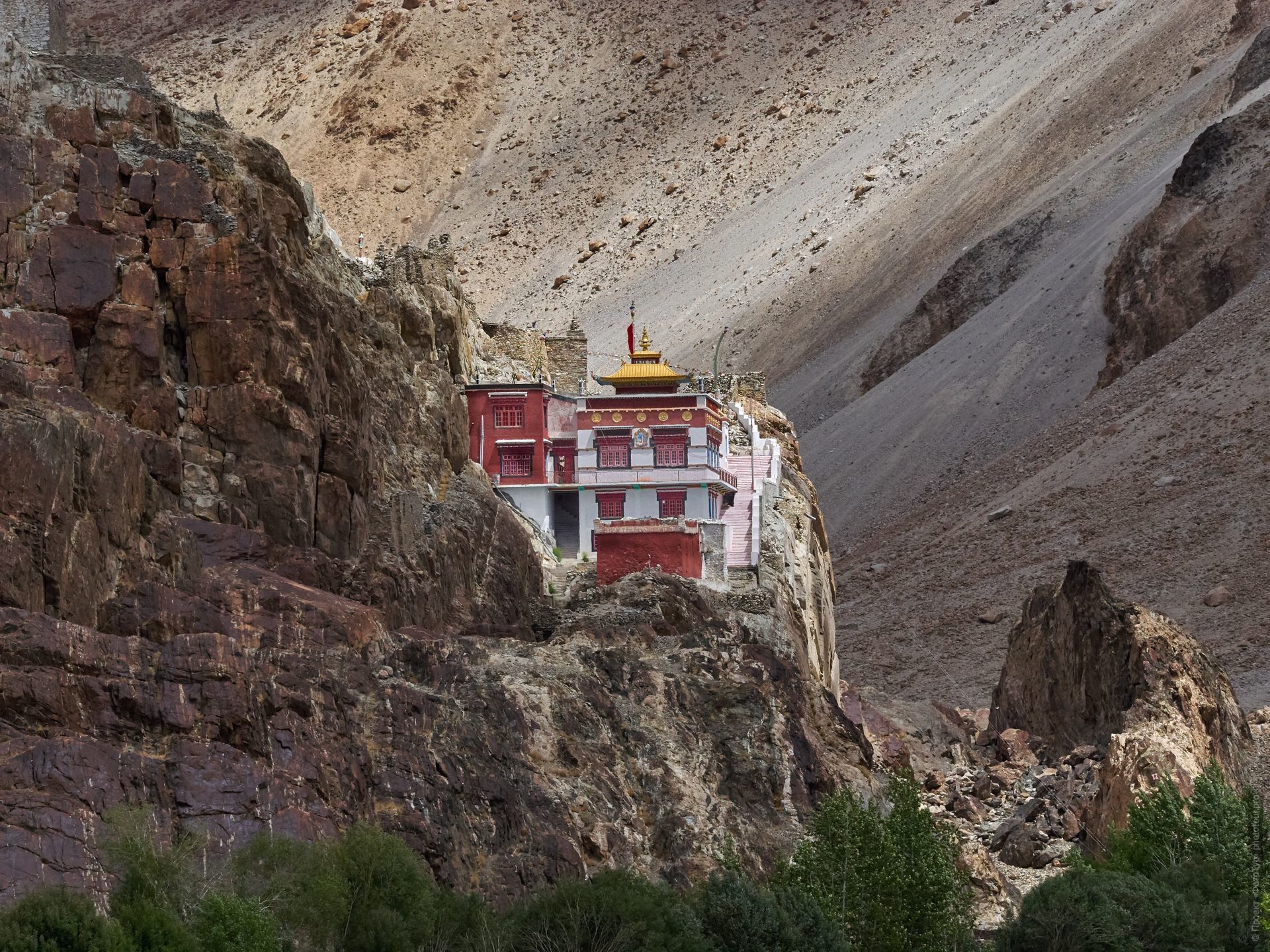
If we are lucky with the weather, then at night we will have to photograph a huge starry sky above Pangong.
And tomorrow from early morning we will go to the Pangong Lake.
Hotel in Tangse.
Day 5, July 24: Lake Pangong Tso, about 50 km, elevation 4,000 - 4,400 m.
Morning photography at Lake Pangong:
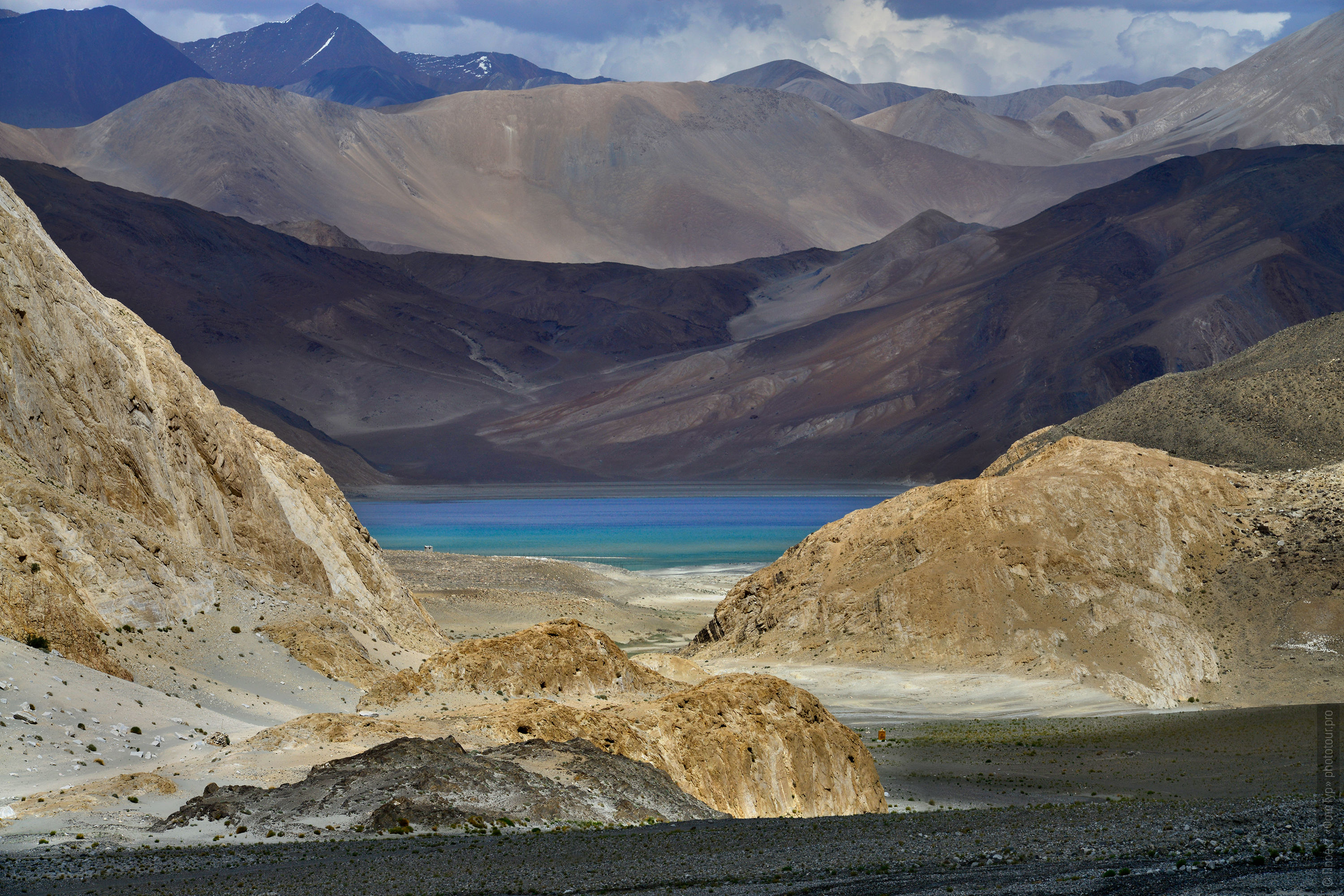
By cars we will go to the far end of the lake (about 16 km) up to the barrier, for which you can drive only to local residents of Ladakh.
And from there slowly go back, stopping at all the shooting points.

Lake Pangong is located at an altitude of approximately 4,250 m and lies on the very border with the former state of Tibet.
The length of the lake is 134 km, width - 5 km. The lake itself at 1/3 belongs to Ladakh (India) and at 2/3 - to Tibet (Tibetan territories under Chinese occupation).

Evening on Lake Pangong.
Free time for self-shooting.
Pangong Tso Lake is very different and time passes unnoticed here.
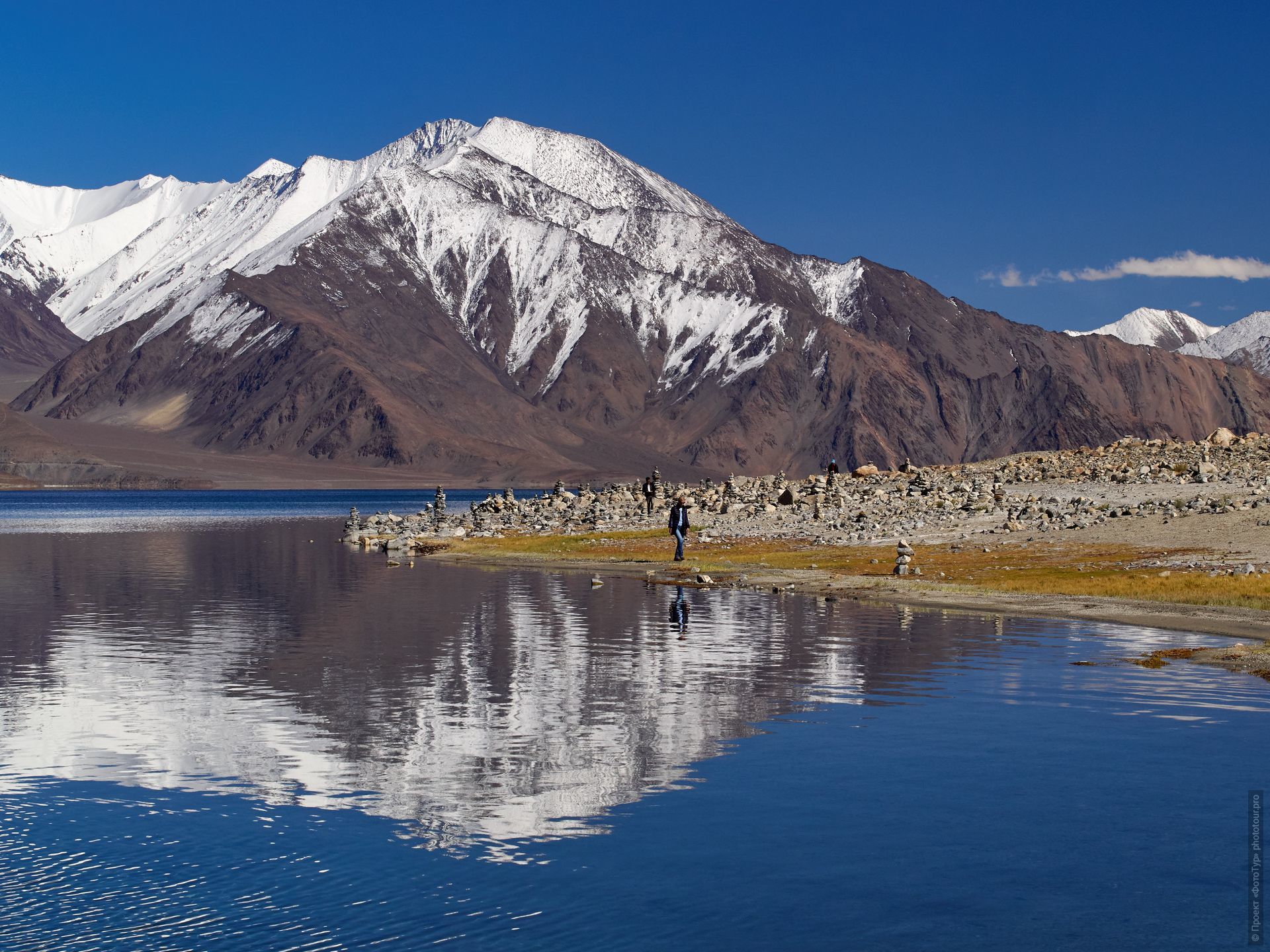
Hotel in Tangtse.
Day 6, July 25: Lake Pangong - Lake Tso Moriri, the village of Karzok, about 342 km, altitude about 4,000 - 4,400 m.
We rise very early in the morning and go on a long journey to Lake Tso Moriri:
today we have to overcome more than 340 km and all along the high mountain routes.
A lot of beautiful landscape photography, the road itself is worth a lot:
Wonderful and photographic miracles are waiting for us all day long, for example, in the morning we will stop at a clearing with hand Tibetan marmots.
The story is this:
a long time ago, 6 to 7 years ago, Indian tourists fed cookies on the glade of Marmots.
The marmots were offered cupcakes and cookies to choose from, first they rushed, then the marmoths came closer and closer, and from some point they took food from their hands.
It got to the point that Marmots began to go out on the road and be on duty on pre-road stone waiting for cars with tourists and already rushed to meet them, demanding delicacy.
At that moment, the environmental services of Ladakh interfered, forbidding feeding unprofitable treats to animals.
But the ban only affected tourists, the Marmots remained tame as before - they fit a distance of 1-2 meters, attentively look at the guests and perfectly pose for photos.
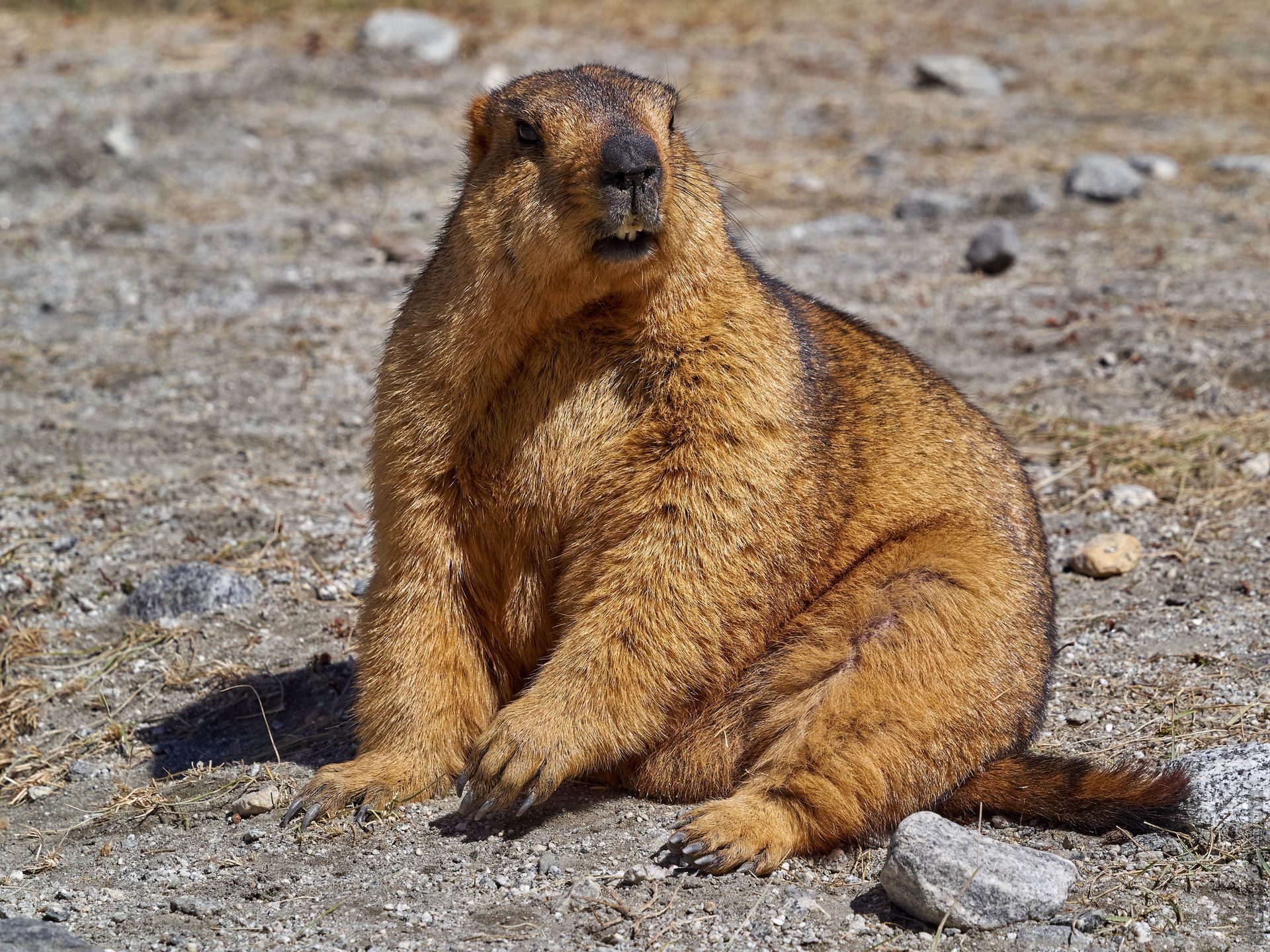
We will drive past Buddhist monasteries hidden in the headwaters of mountain valleys, for example, Chamdey Gonpa:
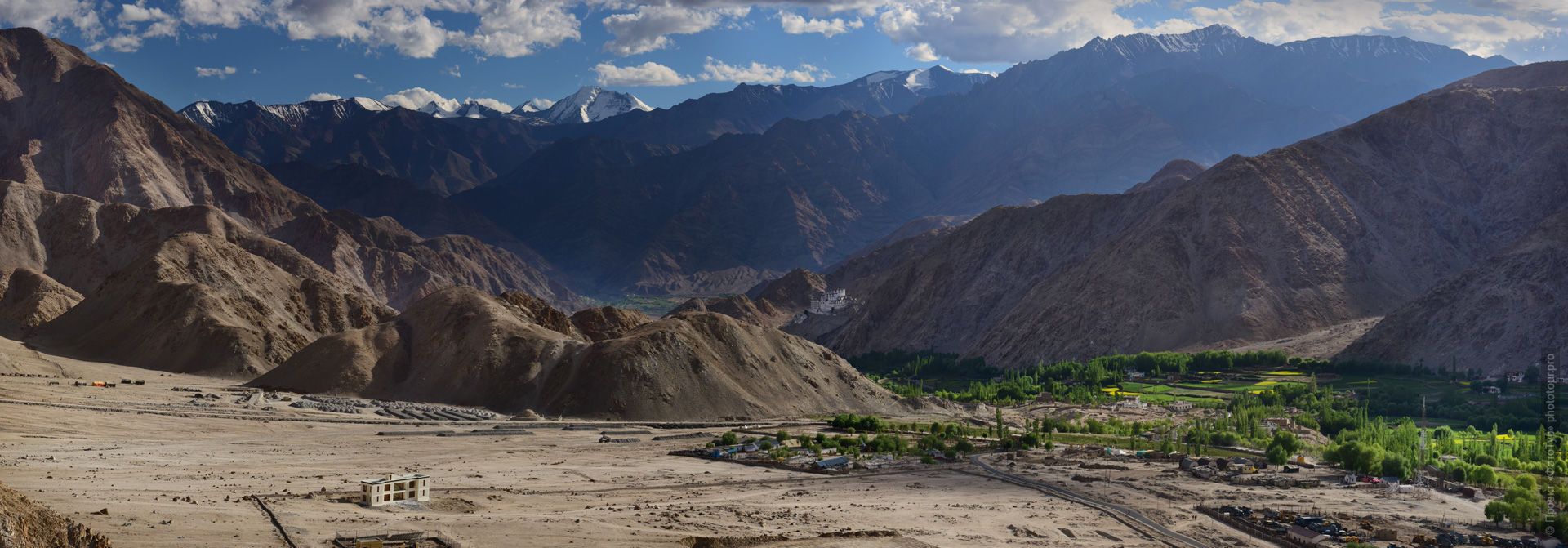
Lots of beautiful landscape photography all day, really a lot.
We stop for taking pictures in all interesting places.
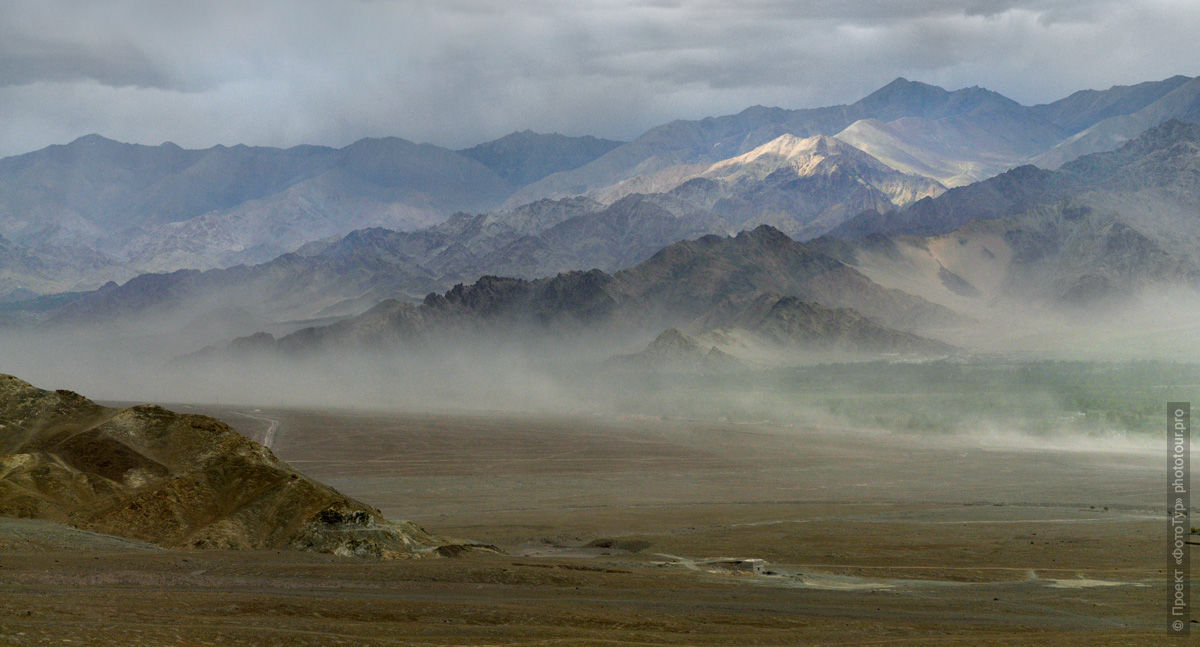
On the way, we will have a lunch stop in the upper course of the Indus Valley.
After lunch we continue our journey and overcome the soft Yalung Nyalung pass (5450 m) and the dusty Rupshu plateau.
On the plateau, we are more likely to meet the nomads of the Chongpa people and will stop to take pictures in their mobile villages:
here is possible and great portrait photography, and genre, and animalistic.
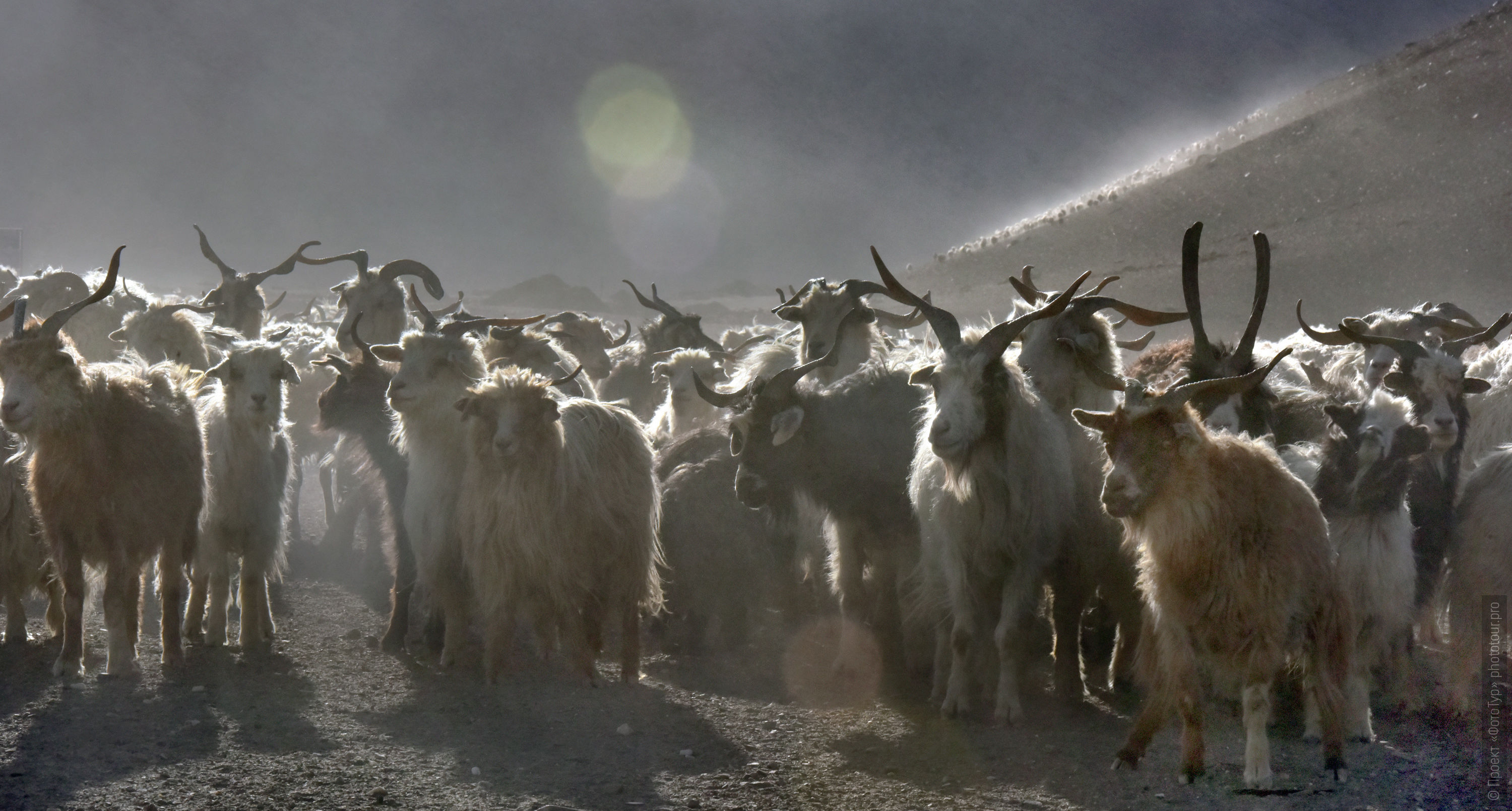
Just beyond the Nyalung Pass, we will have a view of Lake Tso Moriri, unrestrainedly blue in color, like the precious sapphire eye in the rim of brown coasts.
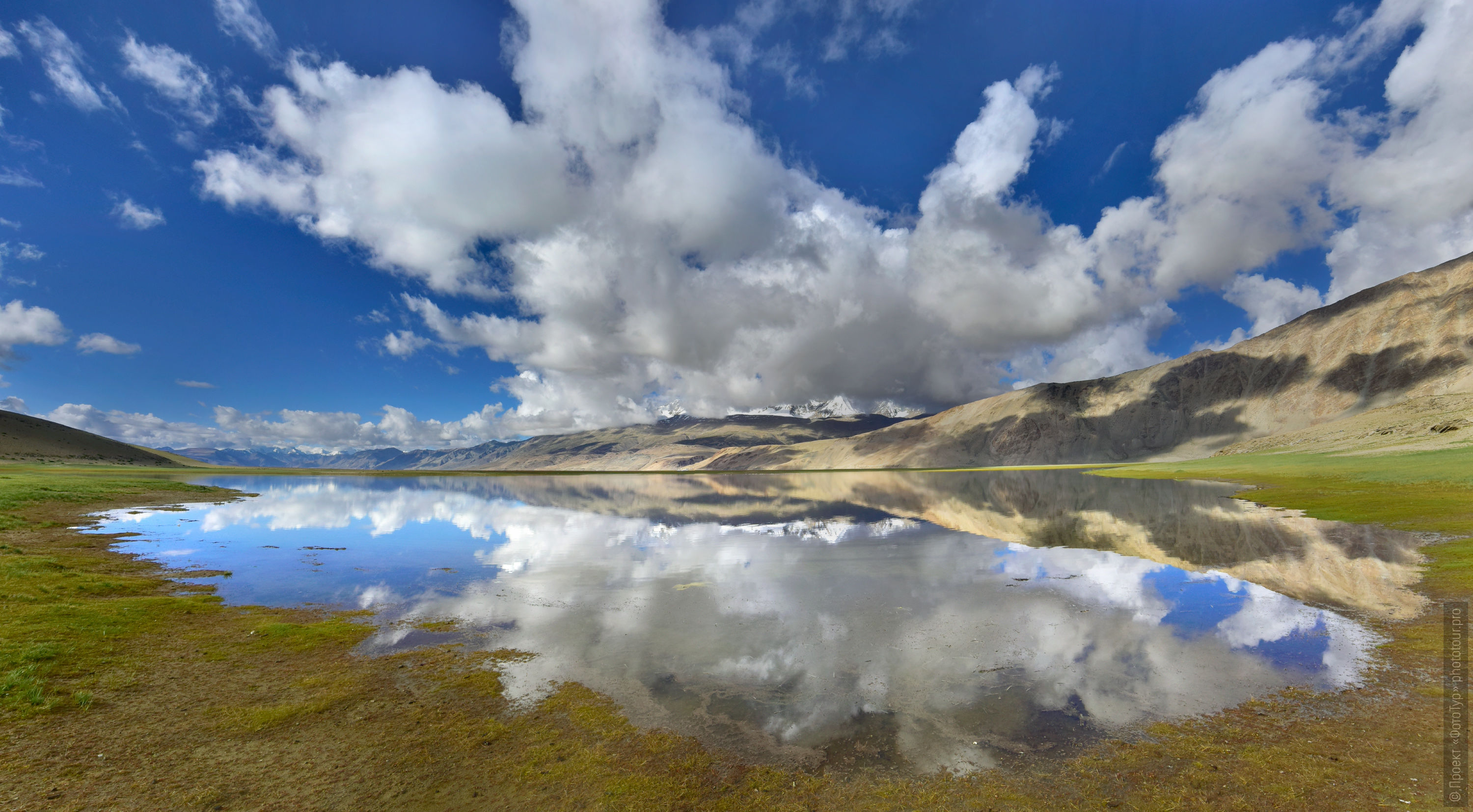
Tso Moriri, Tsomoriri is a beautiful alpine lake in Indian Tibet, located 215 km south-east of Leh, at an altitude of 4595 m above sea level.
The maximum length of the lake is 19 km, the maximum width is 3 km, and the maximum depth is 40 m. This is the largest alpine lake in the trans-Himalayan region within India.
The water in the lake is slightly saline. The lake is available only in the summer season. Until 1959, local residents were engaged in salt mining (zokar, local Ladakhi) from the lake.
On the shore of the lake is the Monastery of Karzok Gompa, where we were at the festival this summer, and a small village of the same name was spread around the monastery.
In summer, the air temperature here varies from 0 ° to 30 ° C, and in winter from −10 to −40.
Live here mainly nomads-shepherds Changpa.

Late in the evening we come to the alpine village of nomads Chongpa Karzok on the shore of Lake Tso Moriri.
Check in at the magnificent hotel overlooking Lake Tso Moriri.
Relaxation.
Hotel in the village of Korzok.
Day 7, July 26: Village Karzok. Lake Tso Moriri. Settlements of nomads ChongPa, about 50 km, height 4 400 m.
Early in the morning we go to the morning pooja in the Buddhist monastery Karzok Gonpa.
On a puja, correct photography is possible.
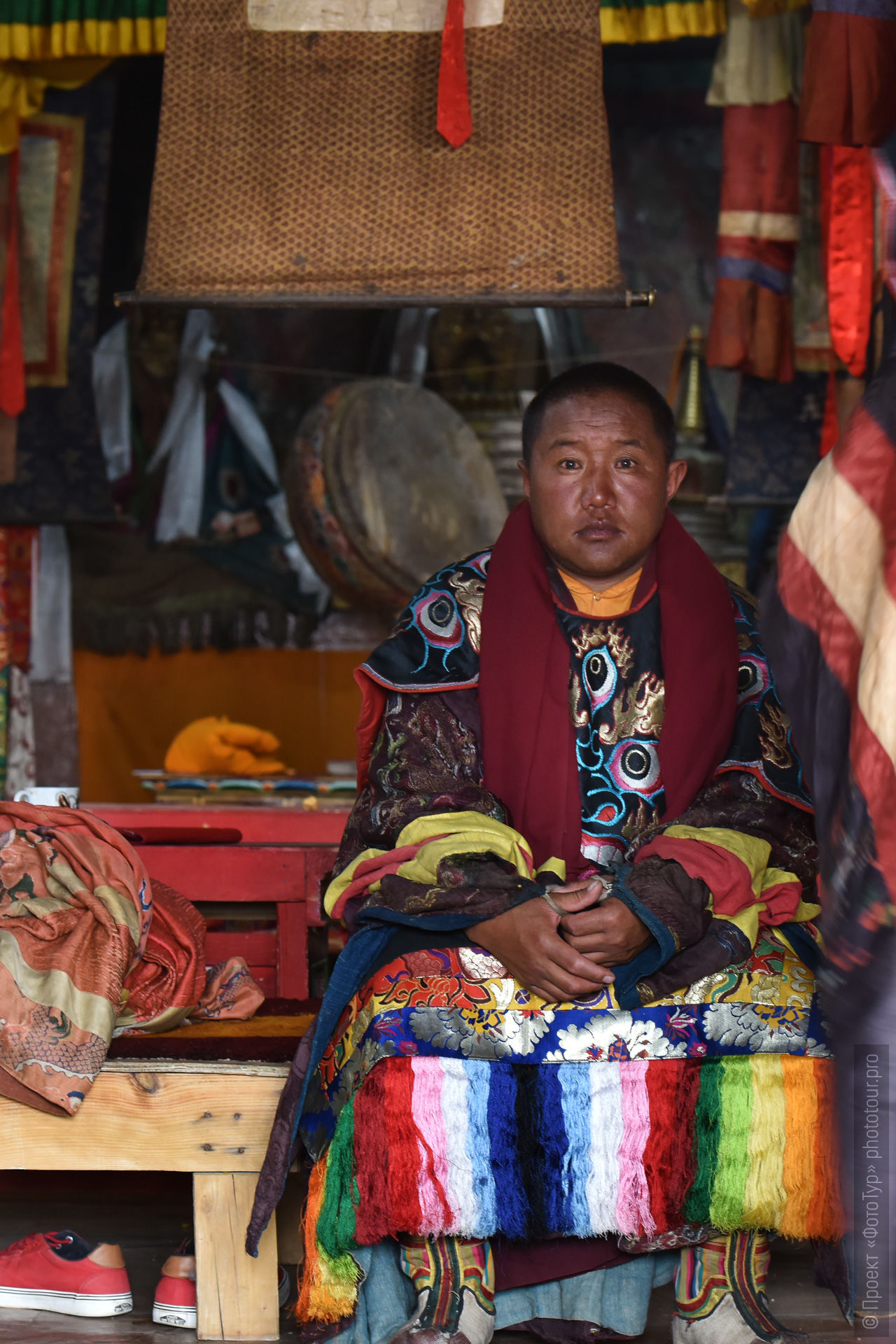
The Buddhist monastery of Korzok Gonpa, also called Karzok or Kurzok, is a Tibetan Buddhist gompa belonging to the Drukpa Kagyu school and an ancient village on the banks of Lhamo Laco.
In Korzok, at an altitude of 4595 m, a statue of Buddha Shakyamuni is installed and about 35 monks live.

Previously, the monastery was the center of the Rupshu valley. As a Drukpin monastery, he submitted to the Hemis Gompa monastery. The monastery is over 300 years old.
The local population believes that both the monastery and Tsomoriri are both holy places.
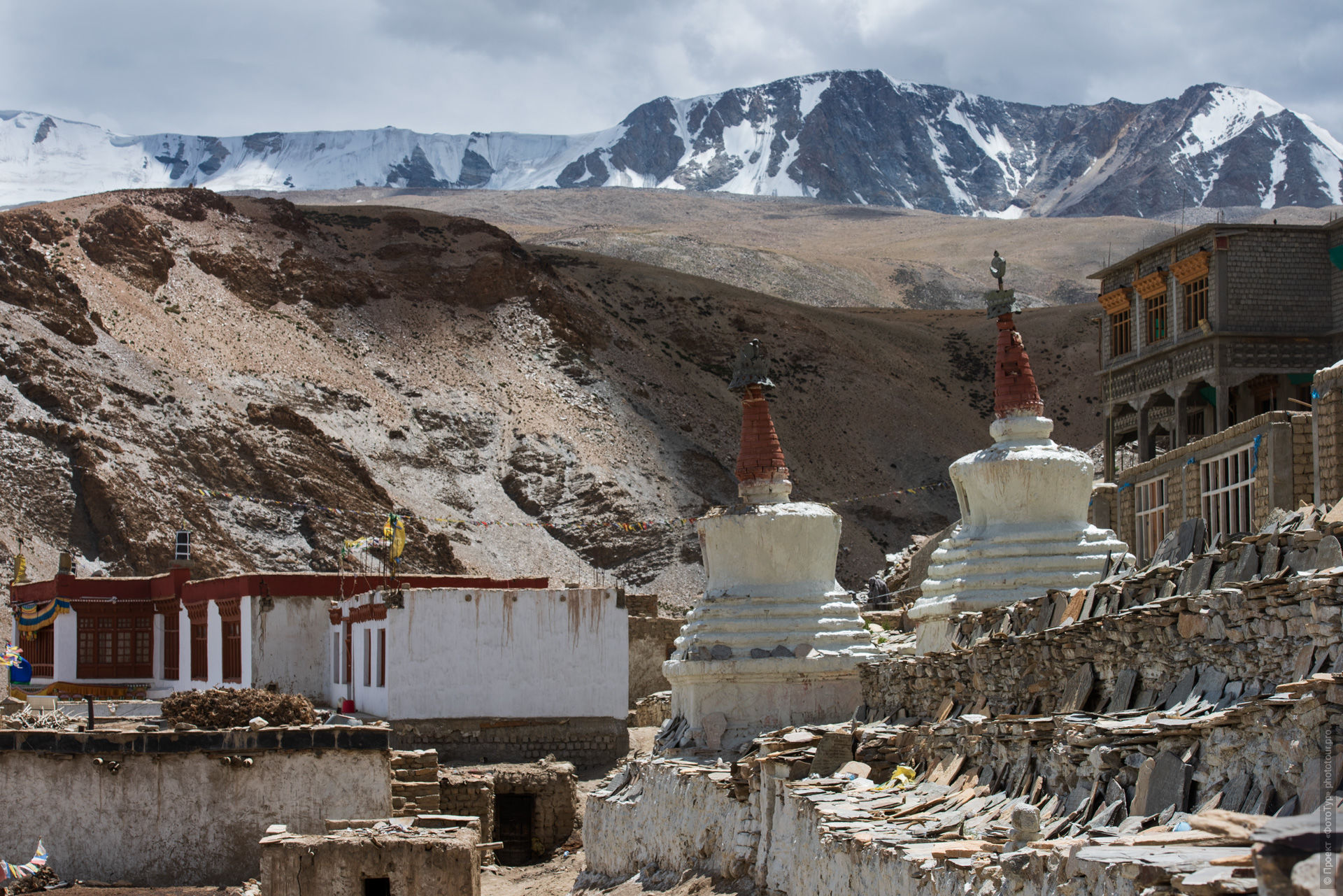
The whole day we will travel around Lake Tso Moriri, landscape photography of the lake from various points.
Let's hope that we are lucky and we will get during our photo tour in stormy weather.
Thunderstorms on Lake Tso Moriri are amazing for taking photos.
The pre-storm Tso Moriri is silence, absolute silence over the lake, the wind subsides and is literally physically felt as the world swells, overflows with a hurricane storm.
But at this moment of calm, an incredible beauty mirror appears in the lake, soft semi-blurry, in pastel colors:

We will also visit the Korzok Fu gorge - the summer pasture of shepherds Chongpa from Korzok.
And we will take pictures in the settlements of the nomads of ChongPa.
And, perhaps, we will be lucky and we will catch the completely serene windless lake Tso Moriri, when the whole world simply becomes double, dual:
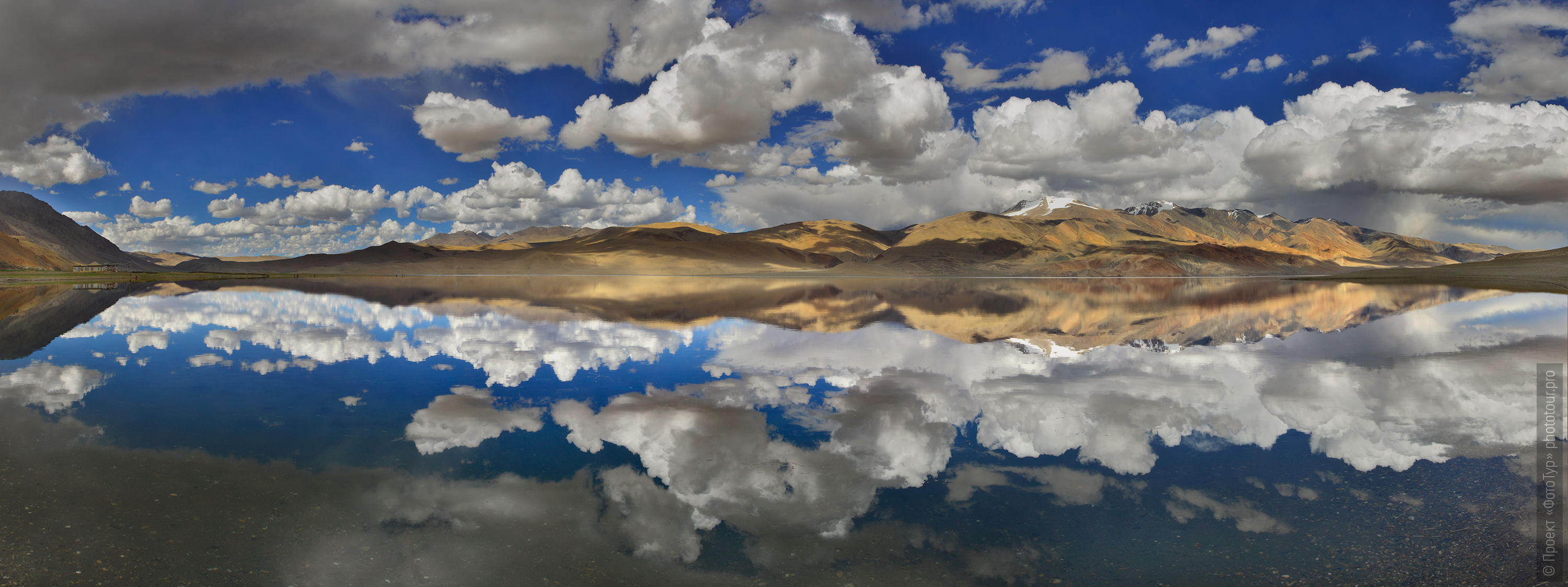
Hotel on Lake Tso Moriri.
Day 8, July 27: Lake Chiagar Tso. Valley of high-mountain geysers - Lake Tso Kar, 60 km, altitude 4,400 - 4,700 m.
Early in the morning we go further along the route of our photo tour:
We only have to drive about 60 km on this day, but we will spend about 6-7 hours on this way and there are several reasons for this:
1. Morning photography on Lake Chiagar Tso: just 17 km from Lake Tso Moriri, there is a beautiful lake ozero - Chiagar Tso.
Our first stop on this day is right here - for morning photography:

2. On the road, we are waiting for the mass of interesting places for photography - from ethnographic photography in nomad camps to macro, animalistic and, if there are correct clouds, landscape photography.
3. Valley of Geysers. Yes, it is on the road from Tso Moriri to Tso Kar that we will visit a unique alpine valley of geysers located at an altitude of about 4500 m.

The geysers here are very different: from small-gurgling huge bubbles to hot glowing fountains of geysers over three meters high.
The Valley of Geysers in the truest sense of the word is a completely fabulous place:
here the climate is changing dramatically under the influence of hot springs and in the middle of the highland desert of Ladakh suddenly appear green alpine meadows mixed with salt marshes, the slopes acquire the brightest colors.
Yellow - exits of crystalline sulfur, among which transparent ammonia crystals, brown, green peels of salts hide.
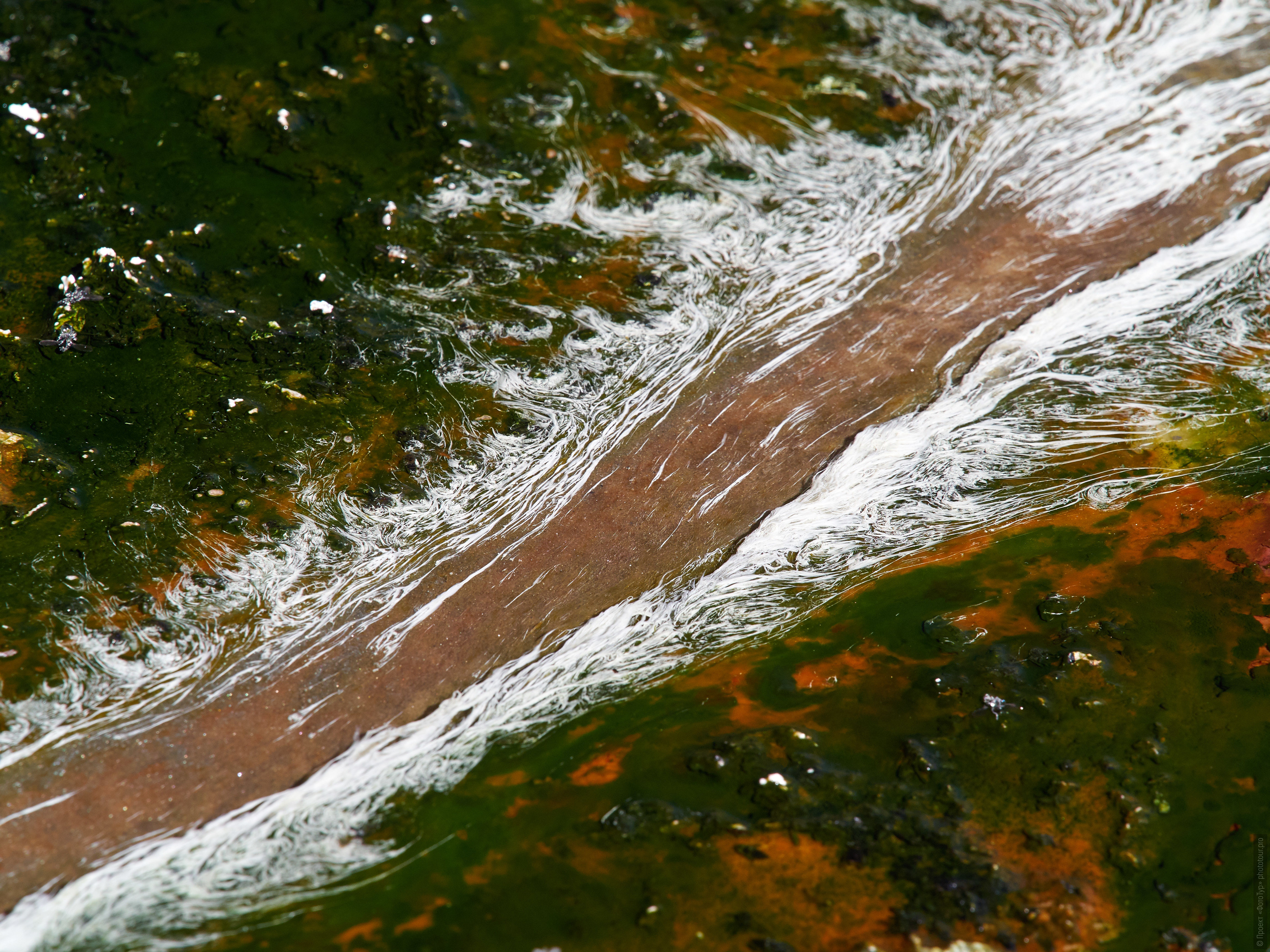
The main thing is that we are lucky with the weather and then photographing in the valley of geysers can be endless:
Birds, which live in enormous numbers on the shores of the valley, small gurgling springs - very textured photographs are obtained, and, naturally, geysers-fountains.
In the springs you can also swim, and not only possible, but the sources are considered to be healing, so do not forget to take bathing suits with you on tour.
The geysers themselves give beautiful bright drawings - paintings.

Later in the evening we arrive at Lake Tso Kar, settle in the campsite and go to the evening photography at Lake Tso Kar.
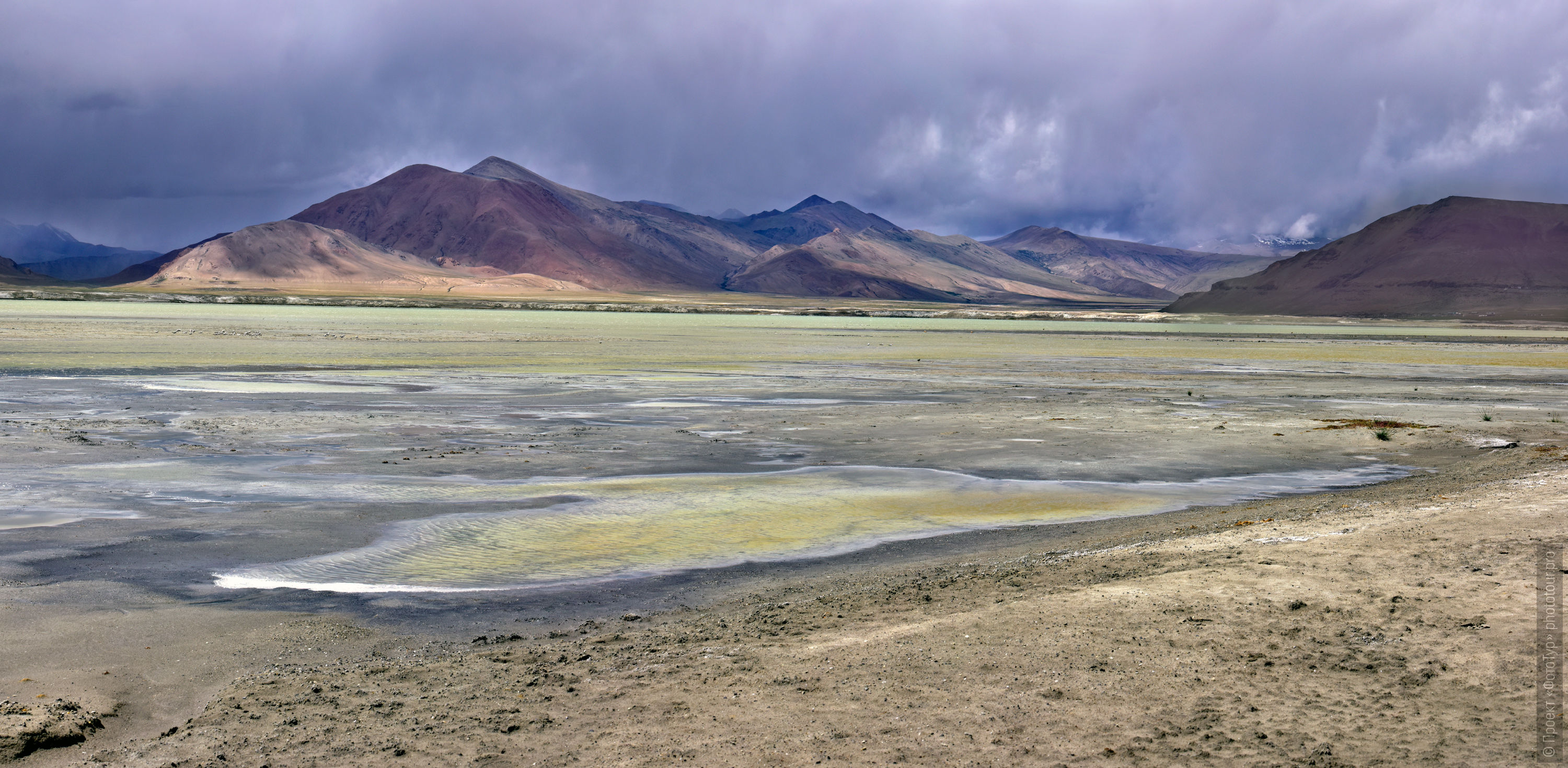
Camping on Lake Tso Kar.
Day 9, July 28: Lake Tso Kar, Lake Tso Startsapak (Tso Startsapuk), about 60 km, elevation 4,400 - 4,700 m.
Day of free photography at Tso Kar and Tso Startsapak lakes:
The first part of the day we take pictures on Lake Tso Moriri, after lunch we go to Lake Tso Startsapak.
The first part of the day on Lake Tso Kar:
we ride around the lake on cars, look for photo points, take morning photos, visit Tso Kara Gompa, and, finally, animal photography:
near the lake, herds of yaks and herds of wild horses graze, which are very close to them.
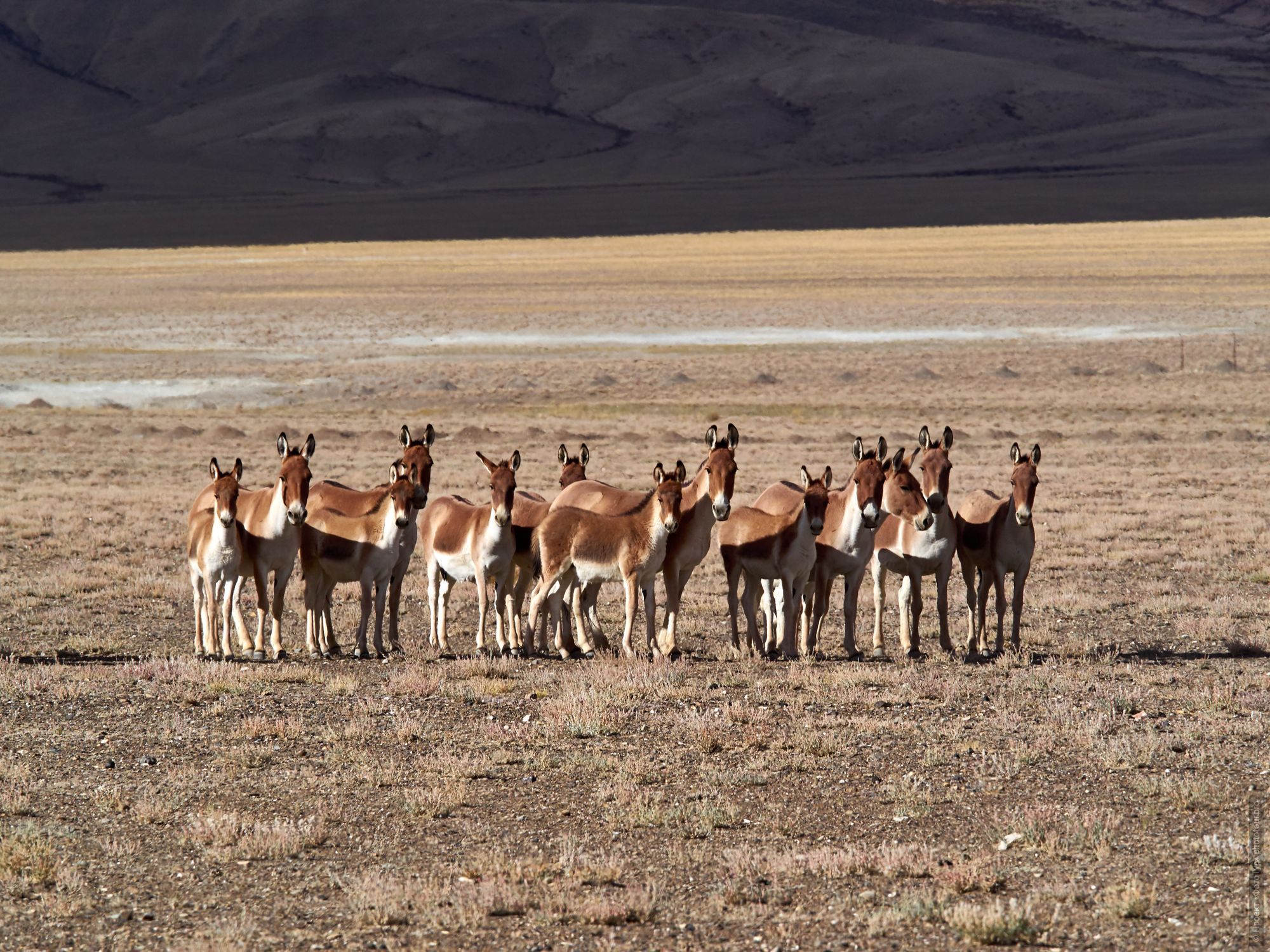
Lake Tso-Kar - perhaps the most charming of the lakes of Little Tibet.
The epithet "beautiful" is not quite right here, Tso-Kar is just lovely: soft colors, half tones, closed miniatures, watercolor colors of the mountains surrounding the lake, calmness and calm.
The word "Tso-Kar" literally translates as White Lake. This lake is named so because the salt and all its shores are covered with whitish salt deposits.
Lake Tso Kar - located 150 km south-east of Leh in the Rupshu valley at an altitude of 4700m.
From a height, Tso Kar looks like this: on the left - Tso Kar himself, and on the right - Tso Startsapak.
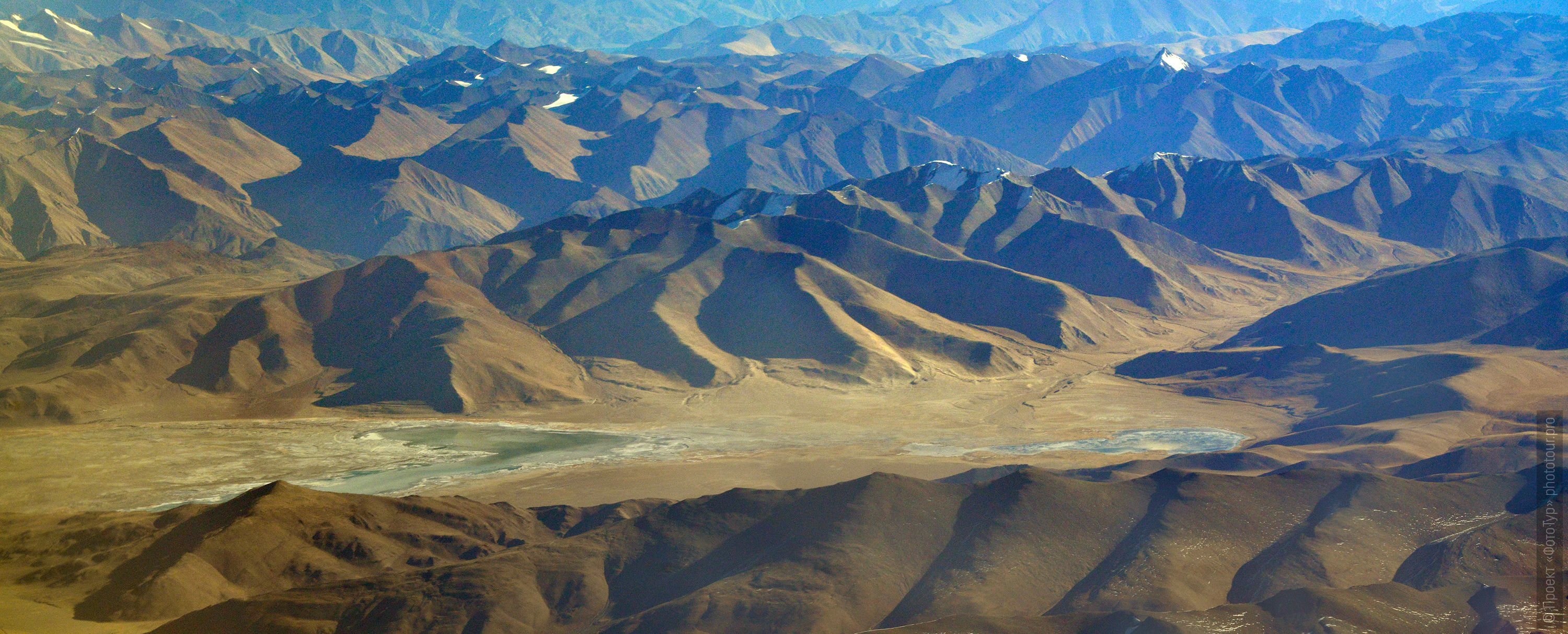
Tso Kar is very capricious and very diverse in all its manifestations:
from the weather, which can change here every half hour to the landscapes - here and the smooth water with mirrors, reflections, and colorful salt marshes, and winding channels of the channel connecting the various parts of the lake.
In the afternoon we go to Lake Tso Startsapak, here it is very good light in the afternoon.
The history of the discovery of this lake by us is amazing: the lake itself is on the map, but it was not immediately possible to find a road to it - there is no road as such, it has not been used for many years.
We ourselves first came to Lake Tso Startsapak in 2014 and were literally fascinated by it:
just 10 km from the snow-salty Tso Kara, we met with the green, gentle and tender beauty of Tso Startsapak.
On the way, we stop to take pictures in the abandoned nomadic villages of Chongpa.
On the way to the Camping - evening photography on the lake Tso Kar.
Camping on Lake Tso Kar.
Day 10, July 29: Lake Tso Kar - Rupshu valley - Tanglang La Rumtse pass (Burgundy gorge), about 100 km, altitude 4,700 (Tso Kar) - 4,000 (Rumze).
On request - an independent morning photo shoot on Lake Tso Kar, and after breakfast we go to the return route to Leh.
We are waiting for a very interesting and rich in landscapes and panoramas alpine road.
We will go up to the second highest pass in Ladakh - Tanglung La (5358 m), and from the height we will see the high-mountain dusty valley of Rupsha.
Photographing in the dusty Rupshu valley and at the second highest mountain pass in Ladakh Tanglung La.
View of the valley of Ladakh from the pass Tanglung La.
This is the road we will go down.
By lunchtime, we descend to a height of about 4,000 in the small village of Rumtse and stop at a guest house.
On foot (there are no roads here) we go to photographing in the village, to the ancient stupas and the ancient monastery Rumtse.
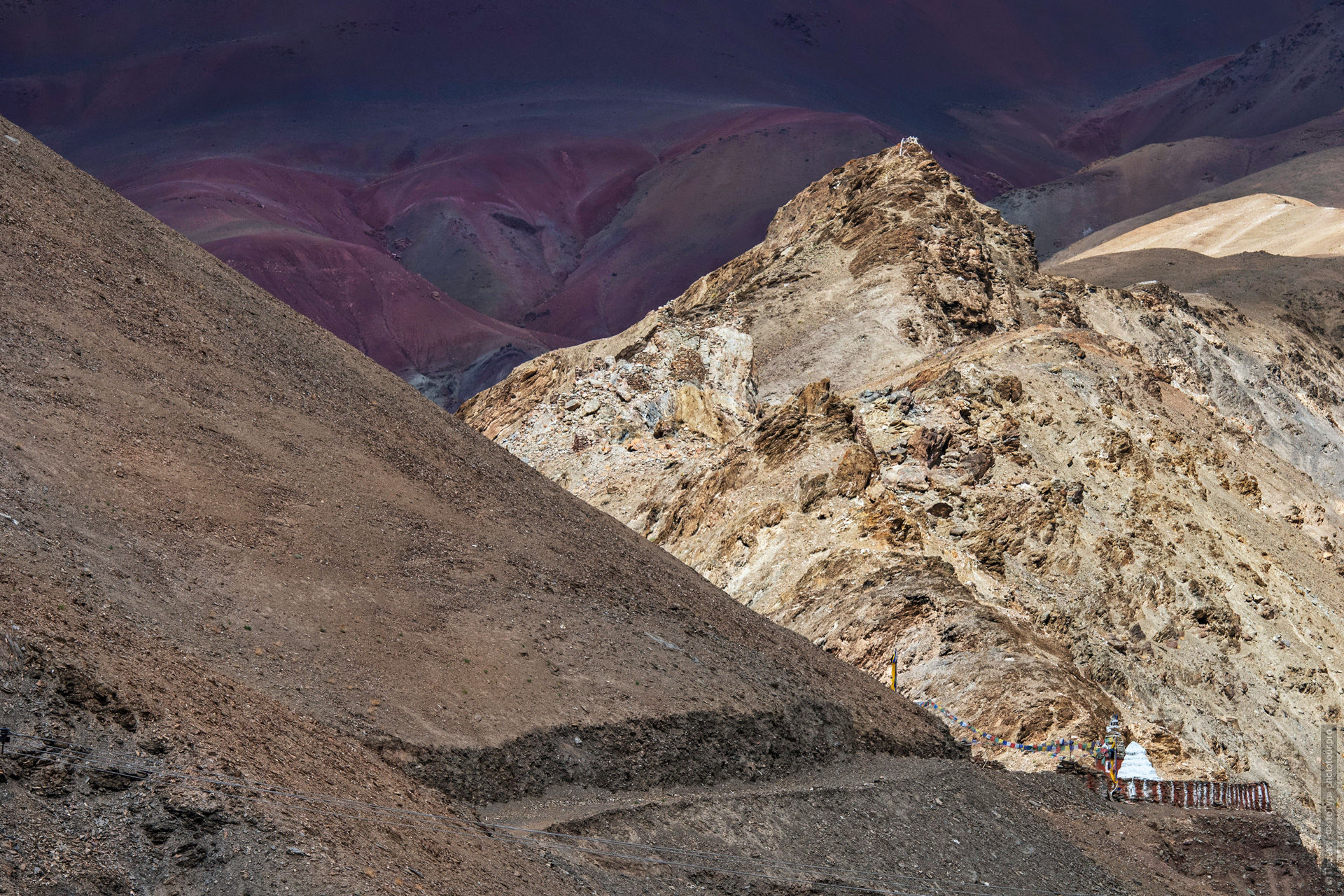
The place here is very atmospheric:
Rumtse village is located at the very entrance to the Burgundy Gorge, against which white stupas and small village houses look amazingly bright.
In the evening - if we are lucky with the sun - we will go by car to take pictures to the Burgundy Gorge.
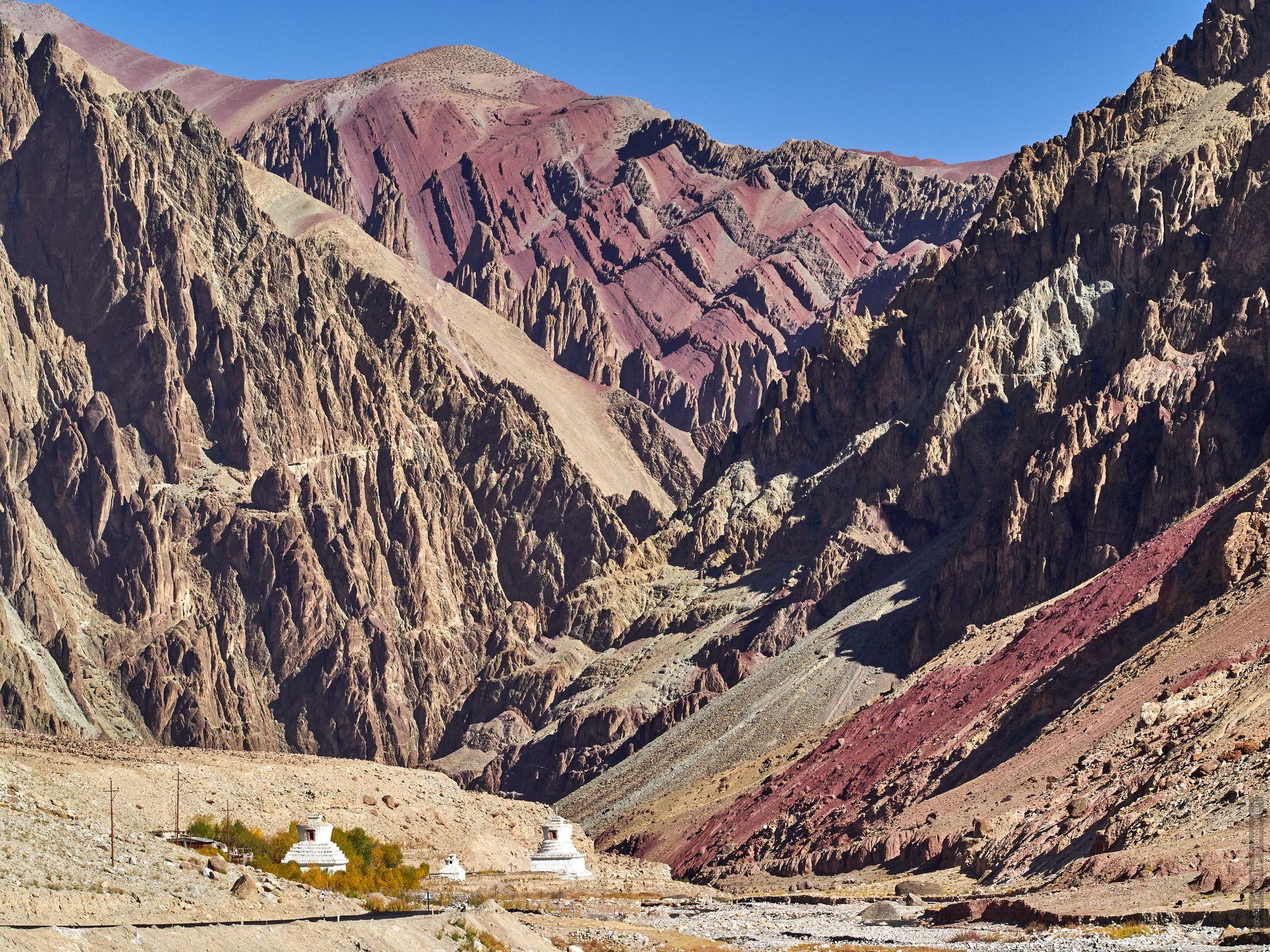
And there are a lot of wonders here - for example, stone mushrooms grow on the slopes and you can wander around with the camera indefinitely.

We return to Leh.
Hotel in Leh.
Day 11, July 30: Free day in Leh. Independent photography in the ancient city of Leh.
Free day in Leh, a day of photography in the old town, as well as:
getting ready for the road, buying gifts for family and friends, walking along the central streets of Leh.
Hotel in Leh.
Day 12, July 31: Leh - Delhi (flight).
In the morning - transfer to Leh airport and flight Leh - New Delhi.
And the alpine mountain ranges of Ladakh are again watching us through the windows of the aircraft.
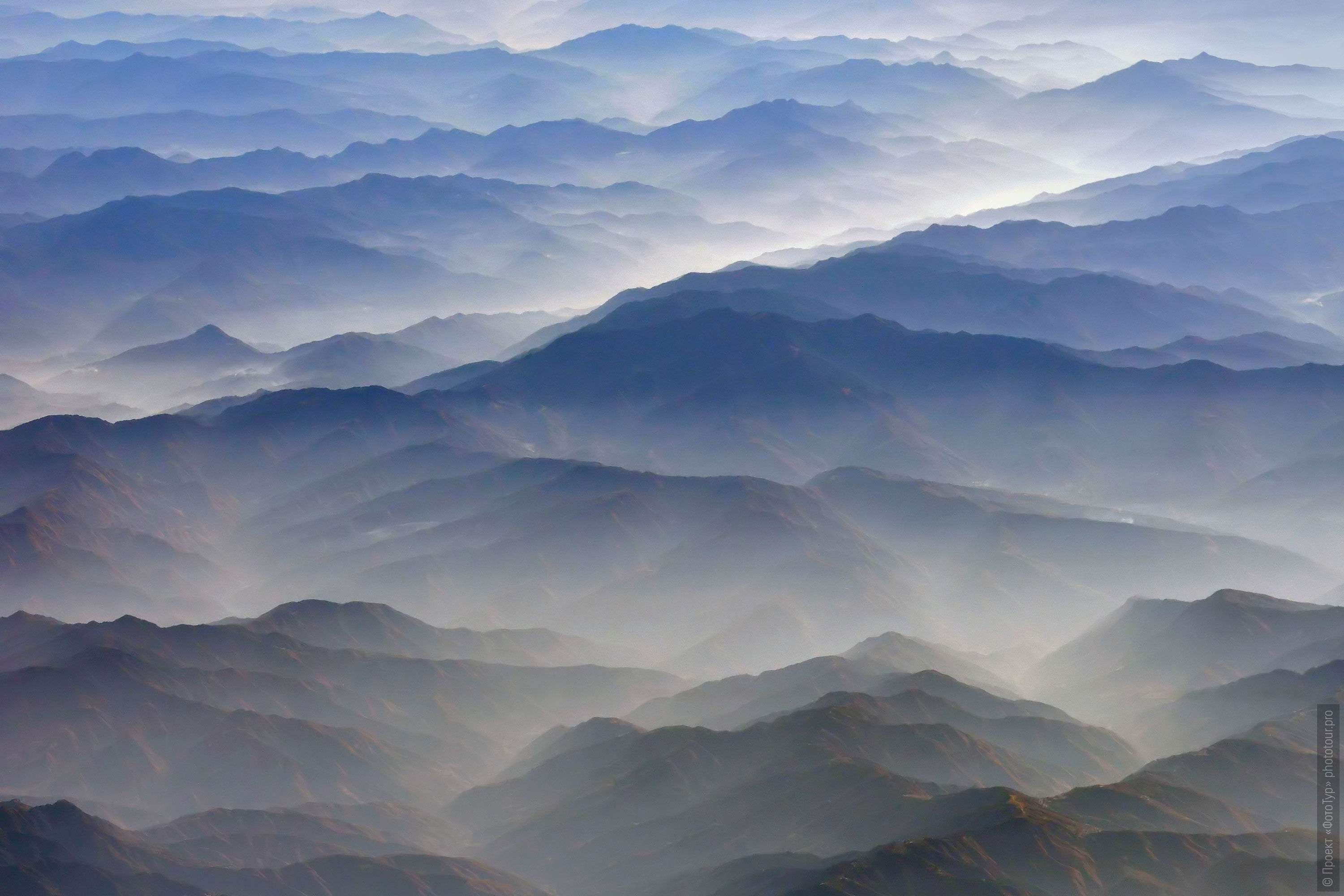
In Delhi, depending on the time of departure, you can either spend time at New Delhi International Airport, or book a tour of Delhi with a Russian-speaking guide.
Departure from the New Delhi International Airport to the homeland.
And at the end we offer to watch a small film about Ladakh and the high-mountainous lakes of Ladakh, shot by a participant of our photo tour Tibet of Lakes, July 2014.
We highly recommend watching this movie:
it reflects not only the events that we will meet in the photo tour of Tibet Lake, but also the spirit of this journey, its mood.
Sergey Pobegaev: LADAKH.
